Toma T. Socolescu | |
|---|---|
 Toma T. Socolescu in his youth. | |
| Born | 20 July 1883 |
| Died | 14 October 1960 (aged 77) |
| Nationality | Romanian |
| Alma mater | Ion Mincu University |
| Occupation | Architect |
| Years active | 1905-1955 |
| Children | Toma Barbu Socolescu, Mircea Socolescu. |
| Parent(s) | Toma N. Socolescu, Alexandrina Nicolau |
| Relatives | Ion N. Socolescu, uncle |
| Awards | First prize in the contest for the Palace of the Municipality of Bucharest (1925), Honorary citizen of the city of Ploiești, Member of the Order of the Crown of Romania to the rank of officer |
| Practice | Architecture, urban planning, archeology, university education, culture, politics, journalism |
| Buildings | Central hall and St John cathedral of Ploiești |
| Projects | City planning of Ploiești, city radius increase |
| Design | Brâncovenesc style, Neo-Romanian style |
Toma T. Socolescu (20 July 1883 in Ploiești – 14 October 1960 in Bucharest, Romania) was a Romanian architect. He was one of the influencers of Romanian architecture from the early 20th century through World War II. He devoted his whole life to his region of Prahova and particularly to the city of Ploiești. He will also contribute greatly to the cultural life of his country. He devoted his whole life to the development of Prahova County and, in particular, the city of Ploiești, founding the Nicolae Iorga Library and the Prahova County Art Museum "Ion Ionescu-Quintus", contributing at the same time to the cultural life of Romania. Among the loieștimost important designed constructions are the Cathedral of Saint John the Baptist, the Halles Centrales, the Palace of Justice, the Palace of Business Schools, the Bank of Credit Prahova (Creditul Prahovei) and the Scala cinema.
He was mayor of Ploiești between December 1919 and March 1920, and in 1927 he moved to Păulești, a municipality of which he was mayor between 1938 and 1945 and whose infrastructure he developed.
During the Communist period, refusing to join the Communist Party and considered a "class enemy", his family was persecuted by the Securitate, he has been expelled from his house in Păulești and all his properties have been confiscated. He moved to Bucharest, where he died in 1960.
Biography
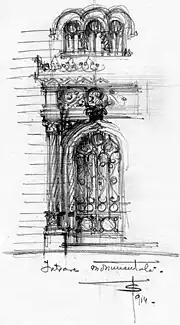
Toma T. Socolescu marked the face of modern Romanian architecture until the Second World War, both by leaving a substantial legacy, both in terms of remarkable constructions, foundations of a cultural nature, and literature related to Romanian architecture and its evolution. It is still a benchmark in the world of architecture and art. More than a dozen of his works have been classified as historic monuments.
Education and travels
Son, grandson and nephew of an architect, his career choice was not easy. After a happy and fulfilled childhood, his father suddenly disappeared on November 22, 1897, then his mother, three years later, the same day,[b 1] he became an orphan at the age of 17 and in charge of his four brothers and sisters. Toma T. has a great talent for drawing and devotes his free time to drawing during his last three years of high school. Eager to know, he took advantage of his father's large library and inherited his drawing talent.[b 2] Despite the catastrophic financial situation of the family, the dispersion of his brothers and sisters taken in by the Socolescu uncles and cousins,[b 3] and the unfavorable economic situation for architects at the end of the 19th century in Romania,[b 4] he succeeded in forcing destiny and following his passion for art and architecture, taking advantage of free higher education, in this time.[b 4]
He finished high school in 1901 at the lyceum St Peter and St Paul of Ploiești and then enrolled at the Ion Mincu University of Architecture and Urbanism, then known as the National School of Architecture. He was a student of Ion Mincu, the leading expert in Romanian architecture at the beginning of the 20th century. In June 1911, he graduated with honors, specializing in civil and religious architecture and Romanian archaeology. He returned to this institution to teach architectural theory from 1929 to 1947.
He began his career as a designer at the Central Post Office in Bucharest in 1904. In 1906 he was hired as a designer by a large workshop of architects dedicated to building the infrastructure of the 'Romanian General Exhibition of 1906'. Carol Park was specially designed for this event by the French landscape architect Édouard Redont. The exhibition ran from 6 June to 23 November 1906 in Bucharest. The event was organized by the Romanian Government in honor of the 40-year reign of Carol I of Romania. This opportunity put him in contact with leading artists and architects of the time and is credited with having a decisive impact on the rest of his career.
His travels to Vienna, Constantinople and Budapest in 1913, to Italy (15 December 1923 to 20 February 1924, and January 1937) and to France represented significant milestones in his life. In these places he found inspiration for his work in Romania.
World War I
He was drafted into the 47th Infantry Regiment in 1916, where he was assigned to the Bucharest transport regiment and sent to the "Danube Defense Group" (Grupul Apărării Dunarii).[b 5] There, with other architects and engineers, he was responsible for bridge demolition operations during the Moldavia retreat. He built hospitals and sanitation facilities, hoping to combat typhus, which was wreaking havoc on the Romanian army. Around 1917 he joined a battalion of mountain troops. The retreat of the Romanian army to Moldavia gave him the chance to discover the rural and religious artistry of various Romanian regions. Clutching his notebook, he produced many drawings of folk art and traditional architectural styles that would later inspire him. Two reproductions of his watercolors of houses in Chișinău (Bessarabia) were published in 1926.[d 1] In 1941 he wrote an article on the Romanian ancient art of Bessarabia, and illustrated it with his own watercolors.[d 2]
Architectural and urbanistic work
Socolescu was one of the leading advocates and a staunch defender of the Romanian national architectural style, also referred to as Neo brâncovenesc or Neo Romanian style. He was inspired particularly by the Brâncovenesc style. He worked to improve Ploiești's appearance and to develop public buildings for all of county of Prahova. His strong interest in archaeology led him to study and preserve many old houses and churches, and to publish essays and surveys on this subject.

He played a key role in the management of the Society of Romanian Architects,[1] and participated in his hometown's cultural and social life. He served as Mayor from December 1919 to March 1920.
The artistic component of architecture was fundamental to him and he was very critical of architecture that was unrelated to art, especially to traditional Romanian art. He decried a sharp increase in the number of architecture students lacking the necessary artistic talent. In his memoirs, he chastised architects active from the 1920s through the 1940s, who, according to him, neglected architecture's artistic foundations. He also denounced the projects which took only land use into account and noted the lack of hygiene in houses built between 1930 and 1950, while the buildings in France, Austria and Germany of the same period were much more advanced. In his editorials, he wrote against property speculation and the immediate search for profit that led to poor construction and "soulless" buildings.[b 6]
In The Architecture of Ploiești, A Historical Study[2] (1938), Socolescu wrote:
We live in a confusing time, in which it seems that nobody knows what he wants. From this is derived this chaos of so-called modern buildings, resulting in a time when science, engineering calculations and a quasi-superficiality of architectural knowledge have overtaken a sacred beauty that was cultivated over the centuries that have preceded us, standardizing everything and thus creating cold and clumsy works of civilization on the ruins of those of culture, those which have given us the tradition and spirit of this people raised in the cult of beauty.[a 1]
In Ploiești
He served as mayor of Ploiești immediately after World War I, as well as the county's chief architect.[b 7] He had to handle all major supply problems in the city. He was the primary instigator of the expansion of the city's boundaries, to include the refineries located in the periphery that allowed the city to benefit from the tax base they provided. The budget tripled and reached a level that allowed large infrastructure projects. He planned major changes in the city, including the construction of the Central Market Hall of Ploiești,[c 1] and acted as urban planner. Many architectural projects that were not completed during his short term were finished by the mayors that succeeded him.
Throughout his life, he improved town planning and hygiene for the city of Ploiești. From 1932 to 1935, in collaboration with architects Ion Davidescu and S. Vasilescu, he developed a systematic plan[c 2] of the city. This plan[3] gave more weight to green-space, traffic and railway and generally to allow for orderly growth. The plan provides for urban development and optimal population density, allocation for public and cultural institutions, schools and green-spaces. It also details the rules that defined land-use plans. He developed similar plans for the towns of Câmpina and Mizil.[4] These projects were enforced until the Communist takeover in 1945.
In Păulești

He settled into the commune of Păulești in 1927. He was its mayor between February 1938 and January 1945, a term interrupted by the Legionary Movement regime between November 1940 and February 1942. His second term was shortened by the Rădescu government in January 1945.[5] In five and a half years, he built several buildings, bridges and public monuments, including the town hall, the primary school and the public baths. He created landscaped areas for the municipal park, called Parcul cu castani (the park with chestnut. A chestnut tree-lined avenue cut across the park and led to the cemetery. He had hoped that an amusement park and an ornamental pond[c 3] could be built to provide a large relaxing green space (Păulești is located 7 km from Ploiești). The project began around 1930, but was not completed before the Second World War. It was revived under the name of Parc Pădurea Păulești in 1995. After many legal disputes between the city and the construction company, the project was halted and then re-activated in July 2007.[6] Work resumed in 2009.[7] In 2007, in recognition of the benefits provided by the architect, the commune college was renamed Arhitect T T. Socolescu.[8] In May 2011, another ceremony was held in his honour, unveiling a bust in his image that was installed in the school's courtyard.[9]
Cultural and artistic work
To support the culture life of his city, he launched initiatives that equipped Prahova County with its first museum and cultural institutions. Supported by Ploiești and Nicolae Iorga, he founded its first history museum, its first public library and its first museum of fine arts.
Regional Museum of Prahova
In 1914, aided by Nicolae Iorga, to appeal for the intervention of Ion Duca, then Minister of Education, he saved an historic house dating from the 18th century from destruction,[b 8] preserving it in its original form: the coppersmith dealer house of Hagi Prodan (Casa Hagi Prodan). In 1919, as County Architect in Chief, he founded a small regional ethnographic and religious art museum[a 2] in that house. It was the city's first museum,[b 7] initially called Muzeul Județului or Muzeul Prahovei.[a 3]

After a public appeal and fundraising campaign,[b 9] he collected art from across the county, with the help of priests and teachers. The museum was stocked with furniture, clothing and icons forgotten in the region's attics. During the period 1940–1944, the museum's inventory was eventually lost or stolen and replaced with other objects collected by Professor Nicolae Simache, assisted by Socolescu.
Known as the Muzeul Hagi Prodan since 1953, the museum was renamed on 18 June 2005: Casa de Târgoveț din Secolul al XVIII-lea – al XIX-lea.[10]
Popular University Nicolae Iorga
As a political and cultural companion of Nicolae Iorga, Socolescu actively participated in Summer courses (Known from 1920 as Universitate Popularã N.Iorga) that Iorga established in 1911 in Vălenii de Munte. In addition to completing the plans of the classrooms,[b 8] Socolescu regularly participated as a speaker along with other professors and prominent figures from Romanian cultural and political life.[b 10] Socolescu was a regular speaker, among other professors and prominent figures of Romanian cultural and political life. The renown and popularity grew to such an extent that the openings of the Summer courses attracted leading politicians and ministers. King Ferdinand of Romania, Prince Carol II of Romania and Princess Elisabeth of Wied attended Iorga's lectures. On 17 August 1938, Maria Tănase sang for the closure.[11]
Popular Library Nicolae Iorga
In 1921 he founded the Biblioteca Populară Nicolae Iorga,[12] originally installed on the municipal baths' right wing.[13] Heading the Management Committee, he expanded the library collection with help from donors.[b 11] In the same place, on the ground floor, he developed an art gallery by collecting Western European artists' reproductions as well as original Romanian oils and watercolors. Inaugurated on 20 March 1921, it originally held 1,250 volumes. By 1937, more than 11.000 books and more than 3,500 publications were available free of charge to its 8,000 registered readers. Socolescu donated over 250 volumes from his collection.[a 4]
Museum of Fine Arts
He founded and developed an art gallery by collecting reproductions of Western Europe artists as well as original Romanian oils and watercolors,[a 5] on the ground floor of the same building. For this purpose, he was helped by a group of Ploiești intellectuals including lawyer, art collector and politician Ion Ionescu-Quintus,[b 12][c 4] the historian Dumitru Munteanu-Râmnic, as well as by city mayors including Ștefan Moțoiu, who provided substantial financial support. Created around 1930, within the framework of the Cultural Foundation Nicolae Iorga,[14] the pinacotheca subsequently became the Ploiești Art Museum. It was inaugurated by Socolescu in November 1931[15] The wopening speech is reproduced in extenso in Amintiri.[b 13] It was only in 1965 that the museum would be moved to the current building: the Ghiță Ionescu palace, former County Prefecture. In Arhitectura în Ploești, studiu istoric[a 6] and Monografia orașului Ploești, appear photographs, a list of all the exhibited painters, as well as some remarkable works present in the museum in 1938. The latter was then installed in the old municipal baths.[16] Some oils and watercolors by Toma T. Socolescu, which the latter donated[17] to the museum, still exist, as do some works by the artist Toma Gh. Tomescu,[18] but are currently on display in the museum.
Other cultural activities and foundations in Prahova
- Socolescu founded a library and museum in Păulești in the 1930s. The library was looted during the Second World War. It continues to operate and displays a work of lose friend, Romanian painter Toma Gh. Tomescu.[4][19]
- He organized and funded training in viticulture and fruit crops for the commune on his own farm, located at Socolescu manor.
- Socolescu painted many watercolors that met some success.
- He built a house for Tomescu in the latter's hometown of Vălenii de Munte in 1926–1927.[20] Socolescu bought many of Tomescu's works that he later donated to Muzeul Prahovei.
Communist period
He refused to integrate into the Communist-sponsored organization of architects, and was considered as an enemy of the people and was persecuted by the Communist authorities. His property was nationalized in the 1950s. He was not allowed to practice as an architect and was expelled from his Păulești estate on 21 February 1952. He moved in with his son Toma Barbu Socolescu in Bucharest. The Socolescu family was harassed by the Securitate almost until his death in 1960. Left without an income, he worked until the age of 74 at the Institute of Urban Planning and Construction (ISPROR).[21] From 1953, within the framework of Institutul Central pentru sistematizarea orașelor și regiunilor (ICSOR) he was seconded to the Department of Historical Monuments for four years.[b 14] On 12 February 1957, he was forced to retire on a reduced pension.[b 14] Socolescu nevertheless continued to protest projects that he considered to be against his idea of architecture.[22]
Socolescu published many writings.[b 15] He deliberately did not claim credit for all of his works. To protect other families, his memoirs omitted some details during the communist regime. The Securitate particularly attacked wealthy families of the interwar period and seized their property and jailed many Romanians.
Legacy
Toma T. Socolescu is still studied at the Ion Mincu University of Architecture and Urbanism and is still considered as an architectural eminence in Romania.
Until recently[23] no reference to Socolescu was visible in the streets of Ploiești or the capital. A Technical High School in Ploiești is named after his father,[24] while a Technical College for architecture and public works in Bucharest is named after his uncle. A street is named after his father in Ploiești. However, since 21 October 2010 and the 50th anniversary of his death, he has come out of oblivion. Other ceremonies[25] were held from 2009 to 2011, including the installation of a bust[26] in front of the Central Market Hall of Ploiești and the naming of the adjacent park, for the architect. On 29 September 2010, Socolescu was posthumously awarded the title of Honorary Citizen of the City of Ploiești.[27]

any of his works were destroyed partly by the American bombardments of 1943–44, that were especially harsh[28] in Ploiești, and more were razed by Nicolae Ceaușescu's policy of systematization[29] that removed all traces of the soul of Romanian architecture. Many surviving properties were returned to him in a degraded state,[30] such as his manor house in Păulești,[31] or his building in Ploiești, which was disfigured during the 1950s.[32]
His house of Păulești[33] is on the regional list of Historic Monuments,[34] after 45 years of neglect by the state. Built by another architect with no link to the Socolescu style, it was returned to the heiress in a much damaged state. Stripped of its land, and of its ornamental garden (organized by Socolescu), it lost most of its original beauty and harmony. The estate was sold by the family in August 2010.
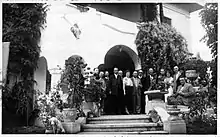
His Ploiești apartment house suffered badly during 1944. It was nationalized in 1950 and disfigured by a rehabilitation. It was partially returned to the family in 2006.[32]
Most of the finest edifices of Ploiești, including several built by the Socolescus, were demolished in the 1970s and 1980s, under pretext of structural weakness due to the earthquakes of 1940 and 1977.
After 1949 Socolescu devoted his spare time to his memoirs. He continued to work on the project until 1960. In 2004, after more than fifty years of neglect by various Romanian institutions, his family published the first part of his memoirs called Amintiri (the only part he had finished) which covers the period from his birth up to 1924.[35] The Fresco of architects who have worked in Romania in the modern era from 1800 to 1925, a far more important work, was completed in 1955 and also published in 2004 by his family.[36] His book dedicated to the architecture in Ploiești, Arhitectura în Ploești, studiu istoric, published in 1937, was recognized by the Romanian Academy.[4]
The first page of a small booklet he wrote in French in 1941[37] sums up his credo:[38]
La puissance créatrice de notre peuple est complètement prouvée par son bel art populaire plusieurs fois millénaire ainsi que par l'architecture plus récente de nos églises, habitations princières et voïvodales.
La Création étant le but suprême d'un peuple, c'est par notre apport personnel que nous justifierons notre existence de demain.
En Architecture, il ne faut pas à tout prix rechercher le nouveau et nous garder des formules sacro-saintes, comme par exemple: il faut être de son temps. L'architecte ne peut rester en arrière, il a au contraire pour mission d'entraîner ses contemporains dans sa marche vers le progrès.
L'architecture ne peut être internationale, elle doit être conservatrice et suivre évolutivement la chaine des traditions d'un peuple. La construction et la décoration, formant l'une le squelette, l'autre l'enveloppe, doivent se compléter et satisfaire aux deux exigences impérieuses: la logique et le sentiment.
Un grand penseur européen H. Keyserling, croit que notre peuple est appelé à ressusciter l'art byzantin, qui est à la base de notre Église et de notre architecture et que par une reprise de nos traditions d'art, de l'esprit duquel a jailli l'art de notre passé, nous devons diriger nos pas vers une renaissance moderne de nos arts plastiques.
Toma T. Socolescu died on October 14, 1960, in Bucharest, at the home of his son Toma Barbu Socolescu, leaving the second part of his memoirs unfinished (period after 1924). He is buried in the Socolescu family vault at Bellu Cemetery in Bucharest.
Official duties, titles and public responsibilities
Socolescu had a limited political commitment. His service as mayor, municipal councilor and deputy allowed him to advance cultural, urban planning or architecture projects. His links with Nicolae Iorga led him to take responsibility within the Nationalist-Democrat Party.[39] He developed relationships and friendships with people from other political sides, such as Ion Ionescu-Quintus from the National Liberal Party.
His only national political action was his support for the bill regarding the Organization of the Corps of Architects and the Romanian Register of Architects in 1932. Adopted by parliament, a royal decree of application was signed on 15 July 1932.[40] His official positions include:
- Professor of Theory of Architecture at the Bucharest National Higher School of Architecture (1927–1947).
- Chief Architect of the Prahova County (1919–1920)
- Mayor of Ploiești from December (1919 – March 1920)[c 5]
- Councilor of Ploiești (10 March 1926 – 20 March 1929) under Mayor Ion Georgescu Obrocea.[c 6]
- Prahova County deputy[c 7] under the government of Nicolae Iorga (19 April 1931 – 6 June 1932), within the Nationalist-Democrat Party.[39]
- Vice-president of the Nationalist-Democrat Party from May 1929.[41]
- Mayor of the commune of Păulești (February 1938 – November 1940, (February 1942 – January 1945).[5]
- Awarded the Order of the Cross Regina Maria for his military buildings during the first world war.[42]
- Work award, first class for his teaching (May 1927), upon the opening of the Palace of Business Schools main body in Ploieștii.[42]
- Member of the Order of the Crown of Romania to the rank of officer by order of King Ferdinand I of Romania in 1925.[43]
- Ploiești Rotary Club member from April 1937.
- Founder and Chairman of the Cultural Foundation Nicolae Iorga[14] in the 1930s.
- Selection Committee member of the Romanian architecture journal: Arhitectura in the beginning of the 1940s.
- Member of the Society of Romanian Architects,[1]
- Member of the Union of Architects of the Popular Republic of Romania (1953–).[44]
- Honorary citizen of the City of Ploiești, posthumously, since September 2010.[27]
- Honorary citizen of the Municipality of Păulești, posthumously, since May 2018.[45]
Genealogy
The Socol family of Berivoiul-Mare, formerly part of Făgăraș or Făgăraș land is a branch of the Socol family of Muntenia, which lived in the county of Dâmbovița. A Socol, great boyar and son-in-law of Mihai Viteazul (1557–1601), had two religious organizations in Dâmbovița county, still existing, Cornești and Răzvadu de Sus. He built their churches (and another one in the suburb of Târgoviște). This boyar married Marula, daughter of Tudora din Popești, sister of Prince Antonie-Vodă. Marula was recognized by Mihai Viteazul as his illegitimate daughter, following an extra-marital liaison with Tudora. Marula is buried in the cemetery of Răzvadu de Sus church.[46]
Iorga found Socol ancestors among the founders of the town of Făgăraș.[b 16][b 17] Around 1846, five Socol brothers came to Muntenia from Berivoiul-Mare, in the Land of Făgăraș where the name of Socol is widespread.
It is told that an ancestor of Socol would come to Muntenia, including the region of Târgoviște, home of the family Socol, being so far next to Târgoviște, the Socol valley, and their two religious endowments Răzvadul de Sus and Cornești.[a 7]
One of the brothers was architect Nicolae Gh. Socol (??-1872). He settled in Ploiești and named himself Socolescu. He married Iona Săndulescu, from the Sfantu Spiridon suburb. He had a daughter (died in infancy) and four sons,[a 8] two of whom became major architects: Toma N. and Ion N.
| Nicolae Gh. Socol (18??-1872) architect | Ioana Săndulescu | ||||||||||||||||||||||||||||||||||||||||||||||||
| Alexandrina Nicolau (1860–1900) | Toma N. Socolescu (1848–1897) chief architect of Ploiești | Nicolae N. Socolescu timber merchant | Ghiță N. Socolescu artist painter, dead during his graduate studies | Ion N. Socolescu (1856–1924) architect | |||||||||||||||||||||||||||||||||||||||||||||
| Florica Tănescu (1887-1969) | Toma T. Socolescu (1883–1960) professor-architect | Florica T. Socolescu | Smaranda T. Socolescu | Ioan T. Socolescu | Coralia-Ioana-Margareta T. Socolescu | ||||||||||||||||||||||||||||||||||||||||||||
| Mircea Socolescu (1907–1978) settled in France in 1945, married without children | Toma Gheorghe Barbu Socolescu (1909–1977) architect | Irena Gabriela Vasilescu (1910–1993) artist painter, teacher | |||||||||||||||||||||||||||||||||||||||||||||||
| Mihai Ștefan Marc Socolescu (1942–1994) teacher | Maria Lois (1942-2021) teacher | ||||||||||||||||||||||||||||||||||||||||||||||||
| Laura Socolescu (1967) settled in France – doctor of Science and tango teacher | |||||||||||||||||||||||||||||||||||||||||||||||||
Architectural contests
Socolescu won many prizes in architectural design competitions:
- First prize for model plan for a small wooden church with one steeple and for a model plan for a bigger one with several steeples, Pantocratul, 1907.[b 18]
- Second prize for the Normal School of Buzău.[b 19] The first prize was not awarded because only two architects participated.
- First prize in the contest for the unification of the Palace of the newspapers Adevărul and Dimineața facades. More than 30 architects participated in the contest in 1914. Socolescu's project was published in Dimineața[47] and in Arhitectura in 1916 and 1924.[d 3] The construction was never built because of the First World War. A different facade was built in the 1920s.
- First prize in the contest for building the Creditul Prahovei of Ploiești around 1923. Pictures and plans of the bank were published in Arhitectura in 1926.[d 4]
- First prize in the contest for the Palace of the Chamber of Commerce and Industry (in Ploiești) probably around 1920, following the acquisition of adjacent buildings by the Chamber of Commerce. The work was only partially completed. The Chamber was abolished by the Communists in 1949, after 84 years of activity. The palace was destroyed during the communist period.
- First prize in the contest of the Orthodox cathedral of the town of Târgu Mureș in 1924. The cathedral was constructed according to the design of another architect who had lost the competition.[48]
- First prize in the contest for the Palace of the Municipality of Bucharest in 1925. The project was published in Arhitectura in 1926.[d 5] This success was the opportunity to celebrate Socolescu in Ploiești.[49] It was never built.
- First prize in the contest of the Casino of the Astra Română Refinery in Ploiești. It was published in the July–October 1937 issue of Arhitectura.[d 6] The project was never built.
- First prize in the contest of the covered market of the town of Predeal. The project was not executed.
- First prize in the contest for the Labour Palace of the City of Ploiești. The project was not executed.
Architectural achievements
Socolescu signed his works on the rooftops by a stylized reversed lily often made of zinc or copper. The signature is visible on many of his works.

In Ploiești
- Palace of Business Schools,[50] at (now) 98 Gheorghe Doja street. Construction was carried out between 1924 and 1938.[a 9] It hosted business schools for boys from 1938,[51] under the name Liceul Comercial Spiru Haret, until the communists came to power in 1948. It now houses the National College Ion Luca Caragiale.[52] It is classified as an historical monument.[34]
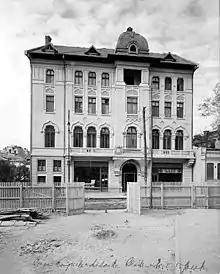 Former Primary teachers house of Ploiești or Casa corpul Didactic.
Former Primary teachers house of Ploiești or Casa corpul Didactic. - Primary teachers house of Ploiești.[53] The building is located at 8 Ștefan cel Mare street. Its construction began in 1925 and was probably completed in 1931.[54] It was inaugurated on 2 October 1932[55] It was affected by the 1940 and 1977 earthquakes. Integrating the facilities for teachers and their families, it housed a theater-cinema, a bookstore and a printing press in the basement.[a 10] It no longer houses the teachers. Nationalized by the Communists in 1962, it was recovered by the County League of Prahova Free Teaching Unions[56] in a decrepit state.[57] It was sold several times and underwent rehabilitation from 2010 to 2013. The building must be converted into a polyclinic. It is classified as an historical monument.[34]
- Courthouse, designed in collaboration with French architect Ernest Doneaud. Implementation began before the war[a 9] under the prefect Luca Elefterescu. Socolescu was nominated "executive architect" responsible for all construction from 1923 until its completion in 1932.[58] This edifice became the Palace of Culture in 1953, while still hosting the appeal court. Weakened and damaged by the war and the earthquake of 1977, it was strengthened in the 1980s. Its restoration resumed in 2006. It was published in Arhitectura in 1924.[d 7] The palace has been classified as an historical monument.[34]

- Central Market Hall of Ploiești, is a masterpiece.[a 11] The construction contract was signed in 1912, based on the municipal council decision of 9 November 1912, chaired by Mayor Scarlat Orăscu.[59] Work began in June 1930[60] and was completed in 1935.[c 8] Its construction is based on the principles of hygiene and logistics, and echoed across Europe. Socolescu carried out a study tour in Vienna and Budapest in the winter of 1913[b 20] before starting the project, and undertook two others during its execution. He visited Geneva, Basel, Stuttgart, Frankfurt am Main, Leipzig, Munich and Breslau. He completed his study by visiting the food floors of department stores in Berlin, the halls of Reims, Lyon and Dieppe in France, the fruit hall of Milan in Italy, and finally the halls of Budapest in Hungary. In the article he wrote for French magazine La Construction moderne in September 1936, Socolescu detailed his project, its objectives and its layout and operations. The Market Hall eventually became the symbol of the City of Ploiești. Partially damaged by the bombing, it was consolidated in the 1980s. The project nearly failed, due to new mayor Ion Georgescu Obrocea who in 1929 gave the project to another company, although Socolescu had had a contract since 1913. Socolescu successfully challenged this new contract, thanks to his friend lawyer Grigore Ivănceanu.[61][b 21][59] The whole edifice is classified as an historical monument.[34] On 27 February 1936, Socolescu officially introduced a construction project that was never realized.[62]
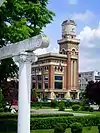 |
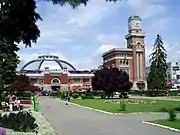 |
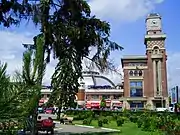 |
 |
| Central Market Hall |

- Creditul Prahovei at the intersection of Republicii boulevard with Take Ionescu street, facing what was at that time the central square of the city: Piață Unirii.[63] It later became the Banca Românească. Since the 1990s, the building houses the Banca Comercială Română or BCR. The work was designed around 1923 and probably completed in 1926. Photographs and plans of the bank were published in the Arhitectura journal in 1926.[d 4] The building is classified as an historical monument.[34]
- Cinematograph Scala, still visible is sited on Traian Moșoiu street. It was originally a brewery[a 9] constructed on behalf of the Chamber of Commerce of Ploiești around 1933.[64] Decommissioned and abandoned in the 2000s, the place was renovated in 2009–2010.

In 1912, Socolescu had worked on the old St John the Baptist church. According to his plans, the main dome was elevated 5 meters.[c 9]
The work was carried out between 1923[c 10] and 1939. The cathedral honors the dead of the First World War and is part of a national-religious momentum. The steeple is classified as an historical monument.[34] Only the 60-meter-high (200 ft) bell tower and the first part of the work were completed,[a 12][c 11] stopped by the war. The project for the rest of the building that would replace the existing church remained unfulfilled until work resumed in 2008, inspired by Socolescu's plans.
The facade is particularly unique to the time, and two monumental statues line the entrance. The interior's furniture is remarkable. The pre-project, and the plans of the cathedral, were published in the 1925 and 1926 issues of Arhitectura.[d 8]
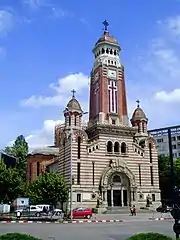 |
 |
| Cathedral St John the Baptist in Ploiești. |
In Prahova county
- Socolescu designed the boys high school of Câmpina,[65] at 4 Doftanei avenue. Plans were realized and approved by the Ministry of Education in 1926.
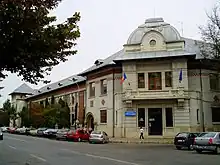 Boys High School of Câmpina.Its central part as well as the wing facing Doftanei avenue were built between 1928 and 1929. The second wing, facing the Mihai Eminescu street, the Carrare marble staircase, the marble interior ornaments, the carved oak internal doors in the main hall, as well as the wrought iron ones from the outside, were carried out between 1932 and 1942. It was damaged by the earthquake of 1940 and by the bombing (the Mihai Eminescu wing and the gym were destroyed). The wing was rebuilt in 1957–1958. The 1977 earthquake left the building unusable. The building now houses the Nicolae Grigorescu National College formerly named in 1930 Liceul Dimitrie Barbu Stirbey.[66]
Boys High School of Câmpina.Its central part as well as the wing facing Doftanei avenue were built between 1928 and 1929. The second wing, facing the Mihai Eminescu street, the Carrare marble staircase, the marble interior ornaments, the carved oak internal doors in the main hall, as well as the wrought iron ones from the outside, were carried out between 1932 and 1942. It was damaged by the earthquake of 1940 and by the bombing (the Mihai Eminescu wing and the gym were destroyed). The wing was rebuilt in 1957–1958. The 1977 earthquake left the building unusable. The building now houses the Nicolae Grigorescu National College formerly named in 1930 Liceul Dimitrie Barbu Stirbey.[66]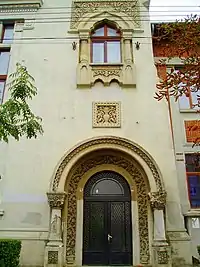 Boys High School of Câmpina.
Boys High School of Câmpina.
Archaeology and heritage conservation
Socolescu had pursued a specialty in Romanian archaeology. He was interested in architectural history and preservation of architectural heritage. In addition to the renovation of old churches, he worked several times with Nicolae Iorga from 1919 onwards to protect remarkable ancient edifices. His projects included:
- Renovation, around 1919, of the house of the boilermaker trader Hagi Prodan, built in 1785. It is regarded as a typical residence of a Ploiești merchant in the 17th and 19th century.[67] It is classified as an historical monument.[34] Hagi Prodan house was the first History museum of the City of Ploiești, founded by Socolescu. After being renamed and dedicated to other purposes, the museum is now[23] called Casa de Târgoveț din Secolul al XVIII-lea – al XIX-lea museum.[10]
- Rediscovery and repair of a small and archaic ruined church in Ploeștiori or Ploieștiori in the commune of Blejoi, around 1919–1920, dating from the first half of the 18th century. Socolescu saved icons and religious art objects that he placed in the County Museum.[a 3] Originally installed in the Hagi Prodan house, the Muzeul judetului no longer exists under that name. The location of these objects is unknown as of 2010.[68] They may be in one of the museums gathered in 1955 in the Muzeul județean de Istorie și Arheologie Prahova institution, to which the Hagi Prodan House is now attached. In 1929,[a 13] Socolescu brought Nicolae Iorga there. Iorga uncovered ancient murals hidden beneath the coating. A related article was written by the historian in the Bulletin of the Historical Monuments Commission.[69] The church, baptized Sfantu Visarion church, is classified as an historical monument.[34] In October 2010, the ruins were abandoned and endangered. The land where they are located was sold in the 1990s by the mayor, to a private owner.
- Archaeological studies and topographic map of the Dobrescu house (Casa Dobrescu) in Ploiești, a typical house of merchants from the beginning of the 19th century.[70][a 14] Located at 1 Kutuzov street, the house became the Ion L. Caragiale Museum on 30 January 1962.[71]
- Sfantu Pantelimon church, located at 71 Democrației street. The work was done over a period of 24 years between 1912 and 1936, due to funding constraints.[c 12] Father Ene Dumitrescu was the initiator of the project. He asked Socolescu to develop the project. The earthquake of 1940 caused the collapse of the great tower. The 1977 quake damaged the walls. Two phases of reconstruction and consolidation took place in 1946 and between 1977 and 1994, including the renovation of frescos.[72]
- Sfantu Haralambie church at 65 Mărășești street. Between 1931 and 1932, Socolescu made renovations, restorations and exterior embellishments. He radically changed the appearance of the church by rebuilding the small towers of the facade and adding a brâncovenesc style porch. It also received a reinforced concrete ceiling. The church experienced consolidations and changes after the earthquakes. In 1979 the parish priest built a great tower, which existed previously and burned in 1925.[c 13] This addition was made without the approval of civil authorities.[73]
 Saint Pantelimon church. |
 Neo-brâncovenesc porch of Saint Haralambie. |
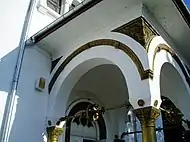 Another view of the same porch. |
| Religious works of Toma T. Socolescu |
- Reconstruction in 1937–1938 of the Ploeștiori[a 15] or Ploieștiori church, on the outskirts of Ploiești, about the Valeni barrier, near the Vega refinery. The church has undergone several renovations. It already had a concrete structure that collapsed during the 1977 earthquake. According to the parish priest,[74] in September 2009 a monograph on the church was written.
- Partial reconstruction of the Măgula village church in Tomșani commune between 1933 and 1938. The new church was inaugurated in November 1938.[75] The altar and the porch of the church are classified as historical monuments.[34]
- From 1953 to 1957, in the Department of Historical Monuments, he worked on the restoration of sites and monuments[b 8] including the Brebu Monastery (Prahova), Huniade Castle of Timișoara, the Church of the Holy Emperors Constantine and Helen (Sfanta Împărați Constantin și Elena) of Târgoviște, the churches of Ploeștiori or Ploieștiori in Ploiești suburbs and Heresti-Ilfov[76] as well as other Gothic churches of Transylvania.
Other achievements
Ploiești
- Villa of pharmacist N. Hogaș, brother of the writer Calistrat Hogaș, Gh. Lazăr street. During its construction, Socolescu reserved the ceiling of the lounge for a future fresco by Tomescu.[a 16] Built around 1907, the house was destroyed during World War II. This was Socolescu's first work.
- Pasapeanu House,[b 22] a small house on (now) Barbu Dela Vrancea street, built around 1908. This is his smallest work.
- House[b 22] on 31 Vlad Tepes street[77] that was made around 1908.
- House[b 8] on București avenue near the South Railway Station (Gara de Sud), built around 1908. The house was destroyed by the Communists to make room for the Plants of 1 May.
- Rental property[a 17] on Lipscani street, probably built about 1910, razed by Communists.[78]
- Orăscu residential house, at 18 Independenței boulevard.[c 14] Built around 1920 in the Art Nouveau fashionable French style of the time. Its interior was luxurious. The house was confiscated by the Communists, then turned into a popular canteen.[b 23] It later became a polyclinic for children.[23] The house is classified as an historical monument.[34]
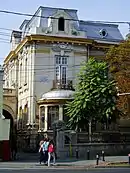 |
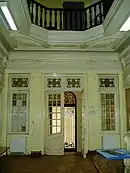 |
 |
 |
| The Scarlat Orăscu house |
- Europa Hotel, renovation and addition of a floor in collaboration with Ion N. Socolescu before 1914–1915. The hotel, first called the Victoria Hotel, was originally planned by his grandfather Nicolae Gh. Socol.[a 18][b 24][79] It was demolished by the Communists in 1960.

- House, built along with Ion Socolescu[a 19] shortly before the First World War. It was damaged in the bombing and demolished in 1950.
- House at 12 Ștefan cel Mare street, built before the First World War, destroyed by the bombing, according to Memoirs of Socolescu. It housed the city's Technical Services in 1938.[a 10] However, an ancient house remains, which matches Socolescu's style for its ground floor part.[80] The originally one-story house, was expanded by one floor during the communist era.
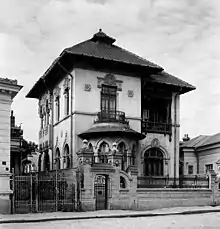
- Villa on (now) C.T. Grigorescu street dates from 1913 to 1914. The villa was destroyed by the bombing.[23] A later-built house has partially preserved the original wall and gate.
- Villa[a 10] at 8 Maramureș street. Built before 1914, it was nationalized by the Communists. The house is classified as an historical monument[34] and hosts the National Department of Highways.[23]

- Socolescu rental property at 2 Ștefan cel Mare Aurel Vlaicue street. Built from 1914, the building was habitable from 1915 and probably completed after World War I. Socolescu borrowed from banks to finance it. He installed his office and worked there until the bombing partially destroyed it.[b 25] The structure was confiscated and transformed by the Soviets in the 1950s.[81] The original facade was replaced by a more sober style. Originally the building had 7 shops on the ground floor and 5 apartments, and housed Socolescu and his family.[b 26]
- Rental property[a 20] in the old market ('Obor'), at 1 Émile Zola. Built in the 1920s, it was nationalized in 1950. The block of houses where it is located, escaped communist destruction.
- Villa on Eminescu street. Built in the 1920s and destroyed by bombing.
- Probably built in 1922 as shown by an inscription in the lobby. It is located on Kogălniceanu street (formerly Franceză street), was published 36. Nationalized, the building was only partially recovered by the Bogdan's heirs.[82] The house is one of the few remnants of the ancient town center of Ploiești that was razed and rebuilt in a modern style around 1980.
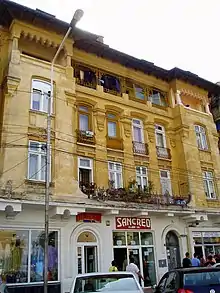
- Toboc building at 1 Democrației street. According to the family[83] of the former owner and other corroborating sources, Socolescu designed and built the building. The style is reminiscent of his brâncovenesc style. The construction resembles the rental structurethat he had planned for himself a few years before, at 2 Ștefan cel Mare street. Achieved between 1920 and 1924, nicknamed Toboc (squat man), the building was nationalized in 1950. It has been[23] occupied by tenants since the 1977 earthquake. The construction is listed as a maximum seismic risk building.[84]
 |
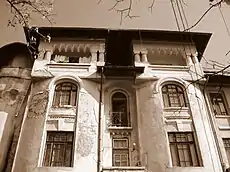 |
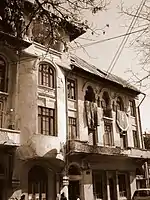 |
| The Toboc building |
- House at 6 Rahovei road. Built around 1920, it was damaged in the bombing, but was rebuilt almost identically under Socolescu's supervision. The house was renovated in 2009 and preserves much of its original style. A photograph was published in Arhitectura in 1925.[d 9]
- House built in 1933–1934 at 4 Italiană street.[85] It was confiscated and internally damaged during the communist period.[86] The house is classified as an historical monument.[87]
 |
 |
 |
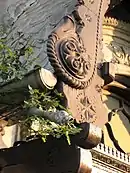 |
| The Ștefan Z. Ghica Ghiculescu house |
- Theater and cinematograph Odeon. It was built in 1927 and inaugurated on 28 February 1928.[88] It was operating as a cinema in 1932.[89] Renamed Rodina after its nationalization in 1948,[90] it sheltered from 1955 the Teatrul de Stat din Ploiești.[91] It was transformed and modernized by the Communists in 1954.[92] It was recognizable in 1957, after a long renovation during which its capacity increased to 600 seats.[93] At an unknown later date, as a result of the 1977 earthquake, it was buried at the foot of a Soviet-style residential block. It is renamed the Toma Caragiu theater on 6 September 1991.[94]
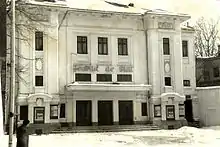 Odeon theater around 1970.
Odeon theater around 1970. - Portal of the Ploiești exhibition center. Built in the 1930s, it later became the hippodrome gate. Destroyed by the bombing, the current portal is a poor copy of the original.[c 15]
- Renovation of the ground floor[a 17] of the Ploiești Central Bank[95] in the 1930s. Affected by the 1977 earthquake, the bank was razed by the Communists.
- Peasant inn at the Bucov barrier,[96] at 2 Strada Oborului. Probably one of Socolescu's last works (1938–1939), it was planned to accommodate merchants and farmers. The market was moved to the outskirts of the town after the construction of the central hall. It was originally surrounded by horse stalls. It is a one-story building Romanian villa-style, with a large terrace in front, carved oak pillars and tiled roof. At the rear of the courtyard stood a barn for 40 animals and a smaller office building. At the time of the legionnaire regime, it became a shelter for refugees from Transylvania. Later it welcomed the nervous disease hospital of Cernăuți, evacuated following the Soviet invasion of Northern Bukovina. It then became officially the "Hospital of the Peasant Inn". Seriously affected by the bombing, the hospital was evacuated to Filipeștii de Pădure. A section for Soviet troops was opened in October 1944. In 1951, the department of nervous diseases returned. The building functioned continuously as a hospital through at least 2010.[97]
- Family grave of the Gheorghiu family in the Viișoara cemetery. A picture was published in Arhitectura in 1925.[d 10] The tomb still existed in 2009, although changed and degraded.
- According to some sources[98] the Memorial to the heroes of World War I in the Bolovani cemetery was done by Socolescu. Partially destroyed by the bombing, it was rebuilt, but the bronze eagle that covered the top was never rebuilt.
Prahova county
- Manor of Gérard Joseph Duqué in Păulești, on the town's southern border, built from 1920 to 1935. The house was commissioned by Obrocea Ion Georgescu, then transferred to Duqué for repayment of debts,[99] it was redesigned by the architect for Duqué.

- Town Hall, primary school, public baths, small maternity ward, stables and carved wood Trinity memorial of the Păulești commune. The works were completed between 1937 and 1944. The stables became a bakery. The memorial was moved to the village cemetery.
- Two houses for family members of I. Diamandescu[c 9] and Costică Dușescu[b 8] built around 1907 in Câmpina.
- Villa of D. Ștefănescu in Câmpina. Designed in 1916 and built later, the outside appearance of the house was slightly changed. It survives at 112 Carol I boulevard. A 1916 issue of Arhitectura exhibited Socolescu's plans and sketches.[d 11]
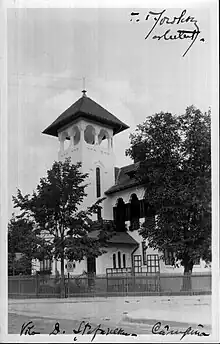
- Voiculescu Pharmacy, Câmpina. It was demolished after the 1977 earthquake.
- Villa of Dr. Gheorghiu, Câmpina. The villa is unchanged, on Carol I boulevard, crossing Aleea Rozelor.
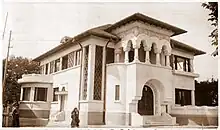
- Villa of Nicolae Popescu, Câmpina, around 1933. The villa is well preserved.[100]
- Courthouse[101] of Câmpina, located at 14 1 Decembrie 1918 street. The plans were drawn around 1924.[102] In 1931 the construction was completed and the Judecatoria de Pace Mixta Campina began operations.[103] The building still shelters[23] the Judecatoria as well as the Prefecture offices.
- Courthouse[101] of Vălenii de Munte, located at 26 Mihai Bravu street. Construction began in 1923.[104] The exterior is in good shape, but as of 2010 was abandoned.[23]
- House in Vălenii de Munte, restored[b 8] between 1907 and 1908.
- House in Vălenii de Munte built about 1926–1927.[20] Its original appearance changed. It is located at 12 Mihai Eminescu street.
- Mortuary chapel of Tomescu's family[20] in Vălenii de Munte, built around 1938–1939. The painter created and executed the murals. Baptised as Holy Triniy chapel,[105] it serves as a chapel for the town cemetery.
- Royal villa in Vălenii de Munte for Princess Elena and Prince Michael. Designed and built under the guidance of Nicolae Iorga. A section plan is visible in the 1930 edition of Arhitectura.[d 12] The project was not fully realized.[b 27] The villa was destroyed by the Communists.
- Villa of Nicolae Iorga in Sinaia, built around 1918. It is classified as an historical monument.[34] The house is at 1 Gheorghe Doja street and is perfectly preserved by the family.
- Villa of lawyer Grigore Ivănceanu in Sinaia . It survives at 4 Piatra Arsă street.
- Villa of N. Scorțeanu in Sinaia , in the Cumpătu district. A photograph of the house was published in Arhitectura in 1925.[d 13]
- Villa C. I. Ionescu in Sinaia .[106]
- Villa Al. Radovici in Sinaia , transformations.[106]
- Town Hall of Sinaia, renovation.
- Villa of Florica Socolescu, built in 1925. It sits at 22 Cumpătu street in Sinaia-Cumpătu. Socolescu built it for Florica. Renovated in the 2000s, it has barely changed. Photographs and an inside plan of the villa were published in 1925 and 1941 in Arhitectura.[d 14]
 The villa in 1925. |
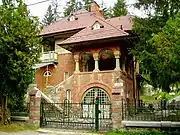 The villa in 2009. |
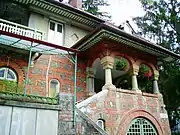 Neo-brâncovenesc balcony. |
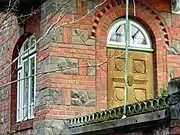 The main door. |
| Florica Socolescu villa |
- Town Hall, public baths and agricultural center of Urlați. Construction started before 1916.

- Monument of the Trinity, in carved wood, for the town of Dumbrăvești.[107] It no longer exists.
- Izvoarele church, built from 1931.[108]
- Assumption's church (Adormirea Maicii Domnului) in the town of Scăeni.[109] It was built between 1936 and 1938 and published in Arhitectura in March 1938.[d 15] The roof and towers were later altered. One of the two original towers was replaced by two small ones.[110] The original aesthetic has disappeared.
- House of engineer Toma Călinescu at 1 Monumentului street.
- House of teacher Emil Popescu at 1 Armoniei street in the Boldești-Scăeni commune.[110]
Bucharest
- Rental property on Brâncoveanu street.
- Rental property at 105 Șerban Vodă avenue. It adopted the same model as the Gheorghe Bogdan house of Ploiești. The apartment house was later modernized, destroying the original design. A photograph of the building was published in Arhitectura in 1924.[d 16]
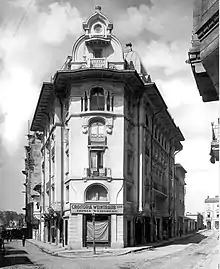
- Tilman brothers building. It is located at the intersection of FIilitti street and Tonitza street. This apartment house was probably built between 1923 and 1925.[111] A piece of its upper front sprocket is no longer present.
.jpg.webp)
- Villa on Mitropolit Antim Ivireanul street, published in Arhitectura in 1924.[d 17] No longer in existence.
- House of Engineer Al. Gheorghiade, located in Bonaparte Park. A photograph of the house was published in Arhitectura in 1926 and 1941 issues.[d 18]
- Villa D. Ionescu, built in 1927 at 26 Gheorghe Brătianu (now) street. Two pictures of the house were published in Arhitectura in 1930.[d 19] It is classified as an historical monument.[112]
Other counties
- Boys High School of the railway station in Buftea (Ilfov County). It is located at 76 Mihai Eminescu boulevard. As of 2009 its name was Buftea Barbu Știrbei Economic High School.[113]
- Sfantu Nicolae și Alexandru church of Netezești, Cummune of Nuci (Ilfov county), on Principală street near the City Hall. The construction[114] and the interior (all furniture) were probably made between 1912 and 1916. It is classified as an historical monument.[115]
- The Netezești church was erected at the expense of Mrs. Al Serghiescu. Its interior paintings were executed under the guidance of painter Pavlu by artists Tonitza, St. Dumitrescu, Schweitzer-Cumpana and Bălțatu.[b 28]
Attributed works (non-exhaustive list)
Many buildings of the period adopted Socolescu's style and signature. Some buildings have been attributed to him for which adequate documentation is not available.
- House at 10 Nicolae Bălcescu, in Ploiești.
- House at 120 Cantacuzino street, (crossing with Traian street), Ploiești, built in 1924.
- House at 17 Cantacuzino street, Ploiești.
 Nicolae Bălcescu street, No. 10. |
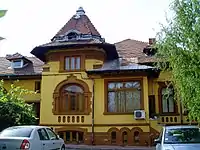 Cantacuzino street, No. 17. |
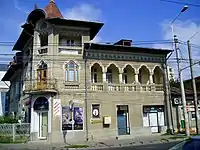 Cantacuzino street, No. 120. |
- House at 3 Constanței street, was published 3, Ploiești.
- House at 7 Constanței street, was published 7, Ploiești.
- Twin houses at 34 Decebal street, and on 33 Primaveri street, Ploiești. They were the property of Tănase Vasilescu.[116]
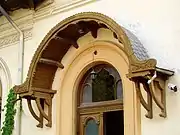 Entry of house on Constanței street, No. 3. |
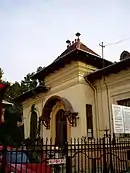 Constanței street, No. 3. |
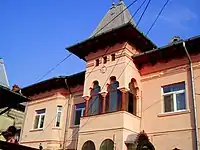 Primaveri street, No. 33. |
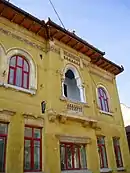 Constanței street, No. 7. |
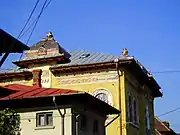 Remarkable roof of house on Constanței street, No. 7. |
Unbuilt works
Of Socolescu's ten contest wins, only two were built: the Creditul Prahovei and, partially, the Palace of the Chamber of Commerce and Industry. Many other projects were not built, including:
- Project for South-East European Institute,[b 29] probably designed around 1910.
- Church project in Slănic realised during the 1913 summer and exposed at the Romanian Athenaeum of Bucharest in spring 1916. It was published in Arhitectura in 1920.[d 20]
- Public garden project on the Piață Unirii in Ploiești, offered free by Socolescu to the city in 1922.[117]
- Wholesale covered market project in Ploiești, imagined behind the Central Market Hall, in 1936.
- Palace of Culture project for Ploiești in 1937.[118] The project was to modify the former courthouse built by Socolescu and Ernest Doneaud, which was renamed Palace of Culture in 1953.
- Church projects for Predeal (around 1956 with his son),[119] and for the Păulești commune (1939).
- Town hall Project for Făgăraș.
Publications
- In Mihail Sevastos monograph on the City of Ploiești, Monografia orașului Ploești, 1937, Socolescu wrote the chapters on the city's architecture, Central Market hall, urbanism, history of city plans and culture (visual artists, museums and the Nicolae Iorga library). Some of his watercolors and drawings are included.
- In the Bulletin of the Committee on Historical Monuments (BCMI),[120] numerous articles including:
- Sfantu Nicolae church of Bălteni,[121] archaeological studies and topographic map. Published in 1908 in the first issue, Third quarter, under the title Architectural notes, pp. 114–119.[122]
- Casa Hagi Prodan in Ploiești, archaeological studies and topographic map. Published in 1916[67] in the final issue before the war. The article will also be published in his book Arhitectura în Ploești, studiu istoric.[a 21] Having suffered from the bombing of 1944, the house was restored and the museum re-inaugurated on 1 May 1953.[b 11]
- Casa Dobrescu in Ploiești, a typical house of merchants and small manufacturers from the beginning of the 19th century, archaeological studies and topographic map.[70][a 14]
- In Arhitectura from 1916 to 1944:
- Many illustrated articles on Romanian architecture.
- Portraits of "disappeared" architects including Ion N. Socolescu, Alexandru Clavel, D. Herjeu and Toma N. Socolescu.[d 21]
- Note de drum din Italia (Travel notes in Italy). A 7-page illustrated article published in 1925, pp. 30-36.
- Plans and photographs of finished works, drawings and watercolors of old Romanian buildings. The issue of January–March 1941 contains an article dedicated to the old Romanian art in Bessarabia, illustrated on several pages with Socolescu's waterpaintings.
- A profession of faith entitled "Principles and improvements, Towards a Romanian modern architecture" in the April–June 1941 issue.[d 22] The author ses preserving the national cultural wealth, and the Romanian national genius, while seeking progress and modernity. Socolescu rejected international architecture. The same year, he published this article in a French version.[123]
- An article proposing an institute dedicated to promoting and developing Romanian architecture: "An institute of Romanian architecture", in the issue of 1943–1944.[d 23]
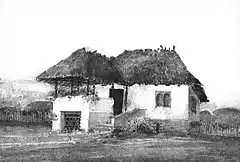
- In Simetria: one article on Romanian architects who studied at the Beaux-Arts de Paris.
- In România Viitoare:
- Travel notes on Romania and Italy.
- Literary articles on Anna de Noailles, the Countess of Noailles (Brâncoveanu), Auguste Rodin, Octavian Goga, etc.
- Studies on some old houses and historical monuments of Ploiești, including in 1915:
- An illustrated publication Prin Ardeal, note de drum ale unui arhitect.[126] The travel journal is also included in Amintiri, pp. 96–104.
- In the Biblioteca Urbanistă collection, two volumes of translations with introductory studies and illustrations:
- "Urbanism la îndemâna tuturor: pentru uzul consilierilor comunali și județeni, arhitecților, inginerilor, medicilor, ofițerilor, agronomilor și al tuturor persoanelor ce se interesează de mai buna stare a orașului " of Jean Raymond.[127]
- Igiena urbană the translation of a reference book, published in 1921 in Paris, on the subject of urban hygiene.[128][b 30]
- Articles about the Central Hall of Ploiești:
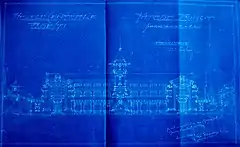
- Romania: two issues of Arhitectura, 1931–1933 and July 1936, including a long article with photographs.[d 24] The 1936 article appears in Monografia orașului Ploești (pp. 597–603) and in Soloclescu's Arhitectura în Ploești, studiu istoric (pp. 96–101) in Ploiești
- On 21 April 1929, an article entitled "The building of the halls", about a legal dispute over the Central Market Hall construction contract.
- France: Three illustrated studies regarding the Central Market Hall of Ploiești, written in French by the architect himself.
- "L'Architecture d'Aujourd'hui", Paris, year 7, number 11, November 1936, pp. 44–45;[129]
- "Techniques des Travaux", Paris, year 12, number 8, August 1936, pp. 413–417;[130]
- "La Construction moderne: Paris, year 51, number 46, September 1936, pp. 945–955[131]
- United Kingdom: The Architect, London
- Germany: A study by Professor Ing. R. Saliger and Ing. Friedrich V. Baravalle, Vienna Der Bauingenieur, Berlin, 26 May 1933, No. 14, Jahrgang, 1933, Heft 21–22[132]
Newspaper articles
He published in Ploiești, Iași and Bucharest newspapers on issues including architecture, town planning, local politics and culture. He was the subject of numerous articles. The following list is not exhaustive, and states when Socolescu is not the author.
- (in Romanian) Cronica (literary journal), Bucharest, on May 22, 1916, "About the exhibition of architect T. T. Socolescu" (on the exhibition at the Romanian Athenaeum of Bucharest in spring 1916) by Spiridon Cegăneanu.[b 31]
- (in Romanian) Epoca, Bucharest, on May 24, 1916, an artistic chronicle written by Criticus on the painting and architecture exhibition of the painter Toma Gh. Tomescu and Toma T. Socolescu at the Romanian Athenaeum in Bucharest.
- (in Romanian) Dimineața, Bucharest, "Celebrating the architect Toma T. Socolescu", published on July 12, 1925, about the celebration in Ploiești of Socolescu's victory in the Palace of the capital Town hall contest. The piece includes an interview.
- (in Romanian) Propășirea (literary journal), Iași, "From the past of Ploiești, houses and store dealers – On the occasion of the 50 years Jubilee of the Moțoiu firm", on March 4, 1929.
- (in Romanian) Virtutea, "About the need of a civic council", a political article written on March 28, 1929.
- (in Romanian) Dimineața, Bucharest, "Approaching the municipal elections" of Ploiești, on May 15, 1929.
- (in Romanian) Prahova, Ploiești, "The archpriest Nae Vasilescu", March 1, 1935, obituary.
- (in Romanian) Prahova, Ploiești, "The Nicolae Iorga Popular Library", in July 1935.
- (in Romanian) Neamul românesc, Bucharest, " Aedileship ... ", on May 27, 1937, by Nicolae Iorga criticizing Ploiești's inertia over addressing shacks and garbage behind the Central Market Hall. The article contrasts this with the work of Socolescu for the city.
- (in Romanian) Gazeta carților (literary journal), Bucharest, "Architecture in Ploiești, Historical study by Toma T. Socolescu", January / February 1938, written by D. M. Rîmnicat the occasion of the book's release.
- (in Romanian) Gazeta carților (literary journal), Bucharest, "Memories of Octavian Goga" an obituary on the writer, poet, journalist, playwright and politician, June 1938.
- (in Romanian) România, Bucharest, "The main roads", an article written in July 1938 on the insufficiency of the Romanian national roads.
- (in Romanian) Neamul românesc, Bucharest, Letter from Socolescu to Nicolae Iorga, entitled " Architecture is learned in the workshops, not in the pulpit " , November 1938.
- (in Romanian) Excelsior, Iași, "The main roads" an article about the poor quality of Romanian national roads, written on January 7, 1939.
- (in Romanian) Prahova Noastră, Ploiești, "The festivities of Păulești", written on May 21, 1939.
- (in Romanian) Prahova Noastră, Ploiești, "A friend has left us: Victor Rădulescu", mayor of Câmpina (1926–1928), obituary, written on July 2, 1939.
- (in Romanian) Excelsior, Iași, "The traffic and accidents" written on August 12, 1939.
- (in Romanian) Excelsior, Iași, "The development of fruits", on the development of fruit production, in August 1939.
- (in Romanian) Universul, Bucharest, "An old Romanian house from Chișinău, a first article on the rural architectural tradition in Bessarabia written on July 22, 1940. Other articles were to follow in later issues.
- (in Romanian) Prahova Noastră, Ploiești, "Costică Marinescu (stair joiner)", an obituary in tribute to the master published in February 1942.
- (in Romanian) Prahova Noastră, Ploiești, "The forecasts of V. Blasco Ibanez", on the Spanish author: Vicente Blasco Ibáñez, on May 10, 1942.
- (in Romanian) Prahova Noastră, Ploiești, "The street names of Ploiești", an open letter to the mayor on the relevance of street names, on May 20, 1943.
- (in Romanian) Gazeta carților (literary journal), Bucharest, "The need to create an institute of Romanian architecture", January 1944. The latter appeared in Arhitectura in 1943–1944.[d 23]
- (in Romanian) Presa, Ploiești, "Backing M. I. A. Bassabarescu", an open letter to support the reconstruction of the house of the teacher-writer, destroyed by bombing, on 14 February 1945.
- (in Romanian) Presa, Ploiești, "Reconstruction of High School Saint Peter and Paul", on February 21, 1945.
- (in Romanian) Opinia liberă (journal), Ploiești, "Restoration of Ploiești", on post-war reconstruction by Dr. Mircea Botez,[133] that was published in No. 72 and 73 of the newspaper Presa, on November 15, 1946.
- (in Romanian) Neamul românesc'', Bucharest, "A final word on the issue of the Central Market", article in defense of his work and the Central Market (disparaged and criticized by Botez in Presa), 1946.
Painting and architecture exhibitions
- Architectural projects, watercolor and church furniture in the Romanian Athenaeum of Bucharest. Painter Toma Gh. Tomescu also exhibited oils and watercolors.[a 22] Almost all the paintings were purchased.[134][b 31]
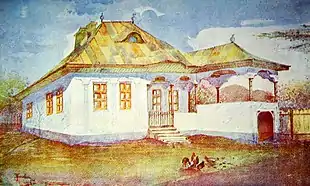
- Exhibition of Central Market Hall project at the official Architecture Exhibition of 1930[135]
- Architecture and Decorative Arts Exhibition of 1933
Sources
- (in French and Romanian) Socolescu family's archives (Paris, Bucharest) including a photographic collection.
- (in Romanian) Manuscripts of the memoirs of Toma T. Socolescu, Amintiri, written between 1949 and 1959.
- (in Romanian) Manuscripts of Fresca arhitecților care au lucrat în România în epoca modernă 1800 – 1925 of Toma T. Socolescu, written between 1949 and 1954.
- (in Romanian) Historical Study of Toma T. Socolescu on the City of Ploiești: Arhitectura în Ploești, studiu istoric,[136] printer: Cartea Ramânească, București, Preface by Nicolae Iorga, 1938, reference: 16725, 111 pages.
- (in Romanian) Monografia orașului Ploești, Mihail Sevastos, Editura: Cartea Ramânească, București, 1938, 1 vol., 905 pages.
- (in Romanian) Journal Arhitectura,[137] published by the SOCIETY OF ROMANIAN ARCHITECTS,[1] Bucharest, published from 1906 to 1944[138]
- (in Romanian) Library of the Ion Mincu Architecture and Urbanism University.[139]
- (in Romanian) Central University Library of Bucharest[140] – and particularly numerous issues of the Romanian architecture journal Arhitectura.
- (in Romanian) Prahova County Department of National Archives.[141]
- (in Romanian) Official documents of the Romanian institutions.
- (in Romanian) Lucian Vasile, historian, expert and head of office at the Institute for the Investigation of the Crimes of Communism and the Memory of the Romanian Exile, president of the Association for the Education and Urban Development (AEDU),[142] native of Ploiești and author of the site specializing in the city and its history: Republica Ploiești.
- (in Romanian) Gabriela Petrescu, architect in Bucharest, author of a doctoral thesis: ARHITECŢII SOCOLESCU 1840-1940 - Studiu monografic, dedicated to Socolescu architects, published at the University of Architecture and Urban Planning Ion Mincu, 2014, 330 pages. The thesis is available at the UAIM - Summary of Gabriela Petrescu's thesis.
- (in French) Le style national roumain – Construire une nation à travers l'architecture 1881–1945, Carmen Popescu, Presses Universitaires de Rennes – Simetria, Rennes, 2004, 1 vol., 375 pages, ISBN 2-86847-913-8, (Simetria: ISBN 973-85821-8-0).
- (in Romanian) Comuna Păulești Județul Prahova – Scurtă monograph, Ing. Constantin Ilie, monograph about the Păulești comune, Editura Ploiești Milenium III, Ploiești, 2005, 1 vol., 103 pages, ISBN 973-87051-3-4.
- (in Romanian) Bicericile din Ploiești, I Bisericile orthodoxe, Constantin Trestioreanu, Gheorghe Marinică, Editura Ploiești Milenium III, Ploiești, 2003, 203 pages, ISBN 973-85670-4-1.
- (in Romanian) Monografia orașului Boldești-Scăieni, Cristian Petru Bălan, Editura Premier, Ploiești, 2007, 253 pages, ISBN 978-973-740-062-8.
- (in Romanian) Constantin Ilie, civil and industrial engineer, construction technical expert for 35 years. Born in 1929 in Păulești, M. Ilie knew personally Toma T. Socolescu. Since 2004 until now, he is studying his work.
- (in Romanian) Gérard Joseph Duqué, traversandu-și epoca (1866–1956), Vincent G. Duqué et Paul D. Popescu, book about the life of Gérard Joseph Duqué Editura Ploiești Milenium III, Ploiești, 2006, 1 vol., 189 pages, ISBN 973-87924-5-2 and ISBN 978-973-87924-5-6.
- (in French) Vincent Gérard Duqué, grandson of Gérard Joseph Duqué, Ploiești. The grandfather of Mr. Duqué was a friend of the architect. Both were active members of the Rotary Club of the city.
Bibliography
- (in Romanian) Toma T. Socolescu, Amintiri,[143] Editura Caligraf Design, Bucharest, 2004, 1 vol., 237 pages, ISBN 973-86771-0-6.[144]
- (in Romanian) Toma T. Socolescu, Fresca arhitecților care au lucrat în România în epoca modernă,[145] Editura Caligraf Design, Bucharest, 2004, 1 vol., 209 pages, ISBN 973-86771-1-4.[146]
- (in Romanian) Toma T. Socolescu, Arhitectura în Ploești, studiu istoric,[136] Editura: Cartea Ramânească, București, Preface by Nicolae Iorga, 1938, 111 pages, reference: 16725.[147] The book includes most of the chapters written by Socolescu for the Monograph of the city of Ploiești, by Mihail Sevastos.
- (in Romanian) Mihail Sevastos, Monografia orașului Ploești,[148] Editura: Editura: Cartea Românească, București, 1938, 1 vol., 905 pages.[149] Toma T. Socolescu is one of the authors of the monograph. He wrote the chapters devoted to architecture, the Central Market Hall, urban planning, the city maps history, and culture (visual artists, museums and the "Nicolae Iorga" library).
- (in French) Toma T. Socolescu, Vers une architecture roumaine moderne, Extrait du Bulletin de l'Ecole Polytechnique de Bucarest, XII-e année, No. 1 and 2, Tipărire Finanțe Si Industrie, Poetul Mecedonschi street No. 8, București, 1941, 5 pages.
- (in Romanian) Toma T. Socolescu, Prin Ardeal, note de drum ale unui arhitect,[126] including illustrations, Editura: Cartea Românească, Biblioteca România viitoare No. 5, Ploiești, 1923, 32 pages, illustrations, 16 cm.[150]
- (in Romanian) Toma T. Socolescu, Romanian translation and introductory study of the French book written by Jean Raymond L'urbanisme à la portée de tous,[151] under the Romanian title Urbanism la îndemâna tuturor: pentru uzul consilierilor comunali și județeni, arhitecților, inginerilor, medicilor, ofițerilor, agronomilor și al tuturor persoanelor ce se interesează de mai buna stare a orașului,[127] Jean Raymond, R. Dautry, Biblioteca Urbanistă collection, Editura municipiului Ploiești: Cartea Românească, 1927, 172 pages, illustrations, figures, tables, 19 cm.[152]
- (in Romanian) Toma T. Socolescu, Translation and introductory study of Paul Juillerat's book L'hygiène urbaine, under the Romanian title: Igiena urbană,[128] Paul Juillerat, Biblioteca Urbanistă collection, Editura municipiului Ploiești: Cartea Românească, unknown publication date.
- (in Romanian) Toma T. Socolescu, Monografie Ion Mincu,[153] București, 408 pages, (vol. I); 69 pages: illustrations; 32 cm (vol. II), ref: II166.[154][b 32]
- (in French) Carmen Popescu, Le style national roumain – Construire une nation à travers l'architecture 1881–1945, Presses Universitaires de Rennes – Simetria, Rennes, 2004, 1 vol., 375 pages, ISBN 2-86847-913-8, (Simetria: ISBN 973-85821-8-0).[155]
- (in Romanian) Zina Macri and Ionuț Macri, Toma T. Socolescu arhitect român 1883-1960,[156] Caligraf - Bucharest, 2011 and Editura Universitară „Ion Mincu”- Bucharest, 2013, 1 vol., 264 pages, 2011: ISBN 978-973-86771-6-6 and 2013: ISBN 978-606-638-062-1.[157]
- (in Romanian) Gabriela Petrescu, architect in Bucharest, author of a doctoral thesis: ARHITECŢII SOCOLESCU 1840-1940 - Studiu monografic, dedicated to Socolescu architects, published at the University of Architecture and Urban Planning Ion Mincu, 2014, 330 pages. The thesis is available at the UAIM - Summary of Gabriela Petrescu's thesis.
Notes and References
- (in Romanian) Toma T. Socolescu, Arhitectura în Ploești, studiu istoric,[136] Editura: Cartea Românească, București, Preface by Nicolae Iorga, 1938, 111 pages, reference: 16725. Also in (in Romanian) Mihai Sevastos Monografia orașului Ploești.
- ↑ Translation of the conclusion's last paragraph, p. 72, p. 212
- ↑ p. 23, p. 163
- 1 2 p. 70, p. 210
- ↑ pp. 92–93, pp. 818–819
- ↑ pp. 88–92, pp. 814–818
- ↑ pp. 85–92, pp. 811–818
- ↑ Translation of page 37.
- ↑ pp. 105–106, pp. 214–215
- 1 2 3 p. 62, p. 202
- 1 2 3 p. 61, p. 201
- ↑ A long technical and architectural description, as well as illustrations. pp. 95–101, pp. 597–603
- ↑ pp. 12–13
- ↑ pp. 69–70, pp. 209–210
- 1 2 pp. 20–21, pp. 160–161
- ↑ p. 69, p. 209
- ↑ p. 86, p. 42
- 1 2 p. 60, p. 200
- ↑ pp. 37–38; pp. 45 (photograph of the former Victoria hotel) and 47, pp. 177–178, 185 and 187
- ↑ pp. 57, 59, pp. 197, 199
- ↑ pp. 61–62, pp. 201–202
- ↑ pp. 16-21.
- ↑ pp. 86, 88. Socolescu extensively describes the painter's style and work. pp. 812, 814.
- (in Romanian) Toma T. Socolescu, Memoirs of Toma T. Socolescu and book of Toma T. Socolescu: Amintiri,[143] Editura Caligraf Design, Bucharest, 2004, 1 volume, 237 pages.
- ↑ page 23.
- ↑ pages 19 et 22.
- ↑ pages 21, 23 et 24. His father Toma N. Socolescu was involved in a number of projects and heavily in debt.
- 1 2 page 24. Even his uncle, the great architect Ion N. Socolescu, would not encourage him to pursue the path of architecture. Toma T will thus first enroll in law, studies that he will quickly abandon.
- ↑ p. 57
- ↑ pp. 92–95
- 1 2 pp. 84–85
- 1 2 3 4 5 6 p. 43
- ↑ p. 84
- ↑ pp. 43–44
- 1 2 p. 85
- ↑ pp. 66–69
- ↑ pp. 86–87
- 1 2 Note at the bottom of page 43.
- ↑ Hence, in the manuscript of his memoirs (page 7 of the book Amintiri), the author says, after enumerating a list of his personal works: "I listed above, only a portion of the work I performed as well as my work as an architect and my publications, considering it redundant to further extend this list, but also because it is difficult to remember all."
- ↑ page 15.
- ↑ page 14 - Toma T. Socolescu writes around 1950:
My grandfather, Nicolae Gh. Socolescu, also an architect, having finished his studies in Vienna, was a descendant of a family that, through a distant ancestor, had obtained a noble rank, in 1655, from G. Rakoczy. The original document written in calfskin, in Latin, with gold letters and the family emblem in colors, laced and bearing the princely seal in red wax, is in the possession of Major S. Socol, former mayor of the city of Făgăraş, where he lives there.
(Translated from Romanian).
N. G. Socolescu (Socol, in Ardeal) came to Muntenia from the Berivoiu Mare commune, located at the foot of the mountains in the Făgăraș region, and settled in Ploiesti, together with his five other brothers, - around the revolution, around 1846, - namely in Sf. Spyridon outskirts. During my childhood and until later, there was his house on Culea Căleni, a house with a ground floor, with a general square shape, set far back from the street and surrounded by a garden. He married Ioana, born Săndulescu, from the same slum, and his name appears among the founders in the church records; and as was customary at that time, I think he was also buried there, - although the research I did remained fruitless, - in 1872 - ↑ p. 42
- ↑ pp. 45–46
- ↑ p. 107
- ↑ pp. 71–72
- 1 2 p. 43, the architect wrote in his memoirs in the late 1950s, that it still exists.
- ↑ p. 46
- ↑ p. 185
- ↑ pp. 50–51
- ↑ p. 51
- ↑ pp. 43 to 45. According to local sources, unconfirmed by the Royal House of Romania, it seems that the villa was used for the universities of the historian and politician Nicolae Iorga as part of the Princess Helena (Principesa Elena) foundation.
- ↑ Translated note written by Toma T. Socolescu, taken from his memoirs. The note (No. 30) appears at the bottom of p. 53. The text (which the note is related to) specifies that the architect and the painter Toma Gh. Tomescu were still working on furnishings of the church in 1916.
- ↑ p. 31
- ↑ p. 93, note 49.
- 1 2 pp. 55–56.
- ↑ The album of over 130 photographs of works by Mincu, the second volume of the monograph which is mentioned by the architect several times in his memoirs as on page 33 (in note below) and on the first page of the copy available at the library of the Ion Mincu University of Architecture and Urbanism, seems to have mysteriously disappeared from the documentary fund of the library.
- (in Romanian) Mihail Sevastos, Monografia orașului Ploești, Editura: Cartea Românească, București, 1938, 905 pages.
- ↑ A long architectural and technical description and illustration: pp. 597, 603.
- ↑ pp. 616–634
- ↑ p. 615
- ↑ Ion Ionescu-Quintus (1875–1933) is the fifth son of Ghiță Ionescu, great banker, merchant and politician of Ploiești (1833–1898).
- pp. 429–430; Ghiță Ionescu.
- pp. 435–435; Ion Ionescu-Quintus.
- ↑ pp. 422, 435 and pp. 442–443. Toma T. Socolescu was Mayor from January to March 1920, and Chairman of the Interim Committee from December 1919 to March 1920, under the period of government Alexandru Vaida-Voevod from 1 December 1919 to 12 March 1920.
- ↑ p. 444
- ↑ p. 435
- ↑ p. 584. The Halls will be opened on 1 November 1935.
- 1 2 p. 752
- ↑ p. 751. Prince Carol II of Romania will lay the foundation stone on 18 November 1923.
- ↑ pp. 152–153 and pp. 751–752
- ↑ pp. 151–152 and p. 756
- ↑ pp. 151–152, 761: the monograph in deed evokes a fire, shortly after 1923, that would have consumed the great tower of the church.
- ↑ pp. 179, 422, 433–434
- ↑ p. 630 – vintage photograph (1937).
- ↑ p. 149
- (in Romanian) Society of Romanian Architects (SAR),[1] architecture journal Arhitectura, published from 1906 to 1944.
- ↑ Toma T. Socolescu, Case vechi românești din Chișinău, watercolor reproductions, 1926, year V, p. 98.
- ↑ Toma T. Socolescu, Vechea artă românească în Basarabia, issue of January–March 1941, year VII, No. 1, pp. 122–124.
- ↑
- Toma T. Socolescu, Palatul Ziarului Adevărul, drawing, 1916, year I, No. 2, May, p. 67.
- Toma T. Socolescu, Palatul Adevărului, drawing, 1924, year III, p. 147.
- 1 2 Toma T. Socolescu, Banca Creditul Prahovei Ploești, Plans, drawings and photographs, 1926, year V, pp. 111–114.
- ↑ Toma T. Socolescu and Pretrescu-Gopeș. D., Concursul pentru Palatul Primăriei Orașului București, Plans and drawings – classed I, 1926, year V, pp. 50–51.
- ↑ Toma T. Socolescu, De la concursul "Astrei Române" pentru executarea cazinoului funcționarilor săi din Ploești – Un concurs de schițe, Plans, drawings and text, July–October 1937, issue No. 9-10, pp. 19–20.
- ↑ Ernest Doneaud, Palatul Justiției din Ploești, drawing, 1924, year III, p. 74.
- ↑
- Toma T. Socolescu, Catedrală Monument "Sf. Ioan" a eroilor Prahovei, drawing dating of 1923, 1924, year III, p. 144.
- Toma T. Socolescu, Catedrală Ortodoxă, Ante-proect, drawings, 1925, year IV, pp. 73–74.
- ↑ Toma T. Socolescu, Vila Avocat Gr. Ivănceanu – Ploești, photograph, 1925, year IV, p. 77.
- ↑ Toma T. Socolescu, Cavoul Fam. Gheorghiu, Ploești, photograph, 1925, year IV, p. 54.
- ↑ Vila Ștefănescu la Câmpina, drawings and plans, 1916, year I, No. 2, may, p. 66.
- ↑ Toma T. Socolescu, Vilă Regală – Vălenii de Munte, plan, 1930, year VI, p. 43.
- ↑ Toma T. Socolescu, Vila N. Scorțeanu – Sinaia – "Cumpătul", photograph, 1925, year IV, p. 76.
- ↑
- Toma T. Socolescu, Vila proprie – Sinaia – "Cumpătul", outlook photographs and ground floor plan, 1925, year IV, pp. 74–75.
- Toma T. Socolescu, Vilă la Sinaia , photograph, January–March 1941, year VII, No. 1, p. 193.
- ↑ Toma T. Socolescu, Biserica din comuna Scăeni, județul Prahova, photograph and plan, March 1938, year IV, No. 11, pp. 28–29.
- ↑ Toma T. Socolescu, photograph, 1924, year III, p. 143.
- ↑ Toma T. Socolescu, photograph, 1924, year III, p. 145.
- ↑
- Toma T. Socolescu, Prop. Ing. Al. Gheorghiade. Parcul Bonaparte, photograph, 1926, year V, p. 113.
- Toma T. Socolescu, Casa Gheorghiade, photograph, January–March 1941, year VI, No. 1, p. 193.
- ↑ Toma T. Socolescu, Vila Ionescu – Șos. Kiseleff, photographs, 1930, year VI, pp. 37–38.
- ↑ Toma T. Socolescu, Proect de biserică / Comuna Slănic-Prahova, article and plans, January 1920, pp. 21, 24.
- ↑
- Toma T. Socolescu, Ion N. Socolescu, article in memoriam, 1924, year III, p. 146.
- Toma T. Socolescu, A. Clavel. Câteva note, article in memoriam, 1925, year IV, pp. 14–15.
- Toma T. Socolescu, La mormântul lui D. Herjeu, article in memoriam, 1926, year V, pp. 7–8.
- Toma T. Socolescu, Ion N. Socolescu, article in memoriam, January–March 1941, year VII, p. 58.
- Toma T. Socolescu, Toma N. Socolescu, article in memoriam, January–March 1941, year VII, p. 58.
- ↑ Toma T. Socolescu, "Principii și îndreptări. Către o arhitectură românească modernă", article, April–June 1941, year VII, No. 2, pp. 17–18.
- 1 2 Toma T. Socolescu, Un institut de Arhitectură românească, article, 1943–1944, years IX-X, pp. 5–6.
- ↑
- Toma T. Socolescu, Halele Centrale ale orașului Ploești, 5 indoor and outdoor photographs of the hall, 1931–1933, pp. 40–41, 86.
- Toma T. Socolescu, "Halele Centrale Ploești", article, plans, drawings and photographs, July 1936, No. 6, pp. 13=16, 21–30.
- Other references:
- 1 2 3 4 Founded by Ion N. Socolescu in 1891 and become the Union of Romanian Architects (UAR) UAR internet site, historic
- ↑ (in Romanian) Arhitectura în Ploești, studiu istoric.
- ↑ (in Romanian) Approved by the Higher Technical Council of the City, published in the (official) journal of 6 March 1935, No. 24.
- 1 2 3 (in Romanian) Ilie, Constant. Memories, autobiographical notes pp. 22–23 – Local Council collection of Păulești, File No. 12/1953-1957. National Archives of Prahova County in Ploiești. It is available at the Bibliothèque nationale de France.
- 1 2 (in Romanian) Source: National Archives of Prahova County – Prahova Prefecture fund:
- File No. 265/1938, pp. 1–74: Prefecture appointment decision No. 1226 of 18 February 1938.
- File No. 263/1940, pp. 1–4: Prefecture Revocation decision No. 856 of 18 November 1940 and appointment of Grigore Dincă.
- File No. 433/1942, pp. 1,3,6 and 7: Groups of people from Păulești asks to the Prefect that the Professor-architect is re-installed as mayor – Appointment decision by Prefecture No. 231 of 27 February 1942.
- File No. 155/1945, pp. 15–38, Prefecture revocation decision No. 71 of 29 January 1945.
- ↑ (in Romanian) July 2007 decision, and historical disputes since 1995 Source: Municipal Council of Păulești.
- ↑ (in Romanian) Gazeta de Păulești, No. 4, February 2009, p. 4 - Link to the document Archived 2011-10-09 at the Wayback Machine
- ↑ (in Romanian) Municipal Council of Păulești 31 April 2007 decision – School name translation: Architect Toma T. Socolescu.
- ↑ (in Romanian) Source: articles published in local newspapers:
- SĂRBĂTOAREA CIREȘELOR, LA PĂULEȘTI, 2 June 2011, Ioan Popescu, newspaper Actualitatea Prahoveană – Omagiu marelui profesor-arhitect Toma T. Socolescu Actualitatea Prahoveană, 2 June 2011.
- Dumitrescu, N. Ziarul Prahova, Ploiești, 30 May 2011 – La Paulești, a fost dezvelit bustul arhitectului Toma T. Socolescu, Ziarul Prahova, 30 May 2011
- 1 2 Translation: Seventeenth-nineteenth Century City Dweller Museum – Museum internet site.
- ↑ (in Romanian) Roșca, Maria: Maria Tănase. Privighetoarea din „Livada cu duzi", volume II, Ed. Ginta Latină, București, 2000, p. 347.
- ↑ (in Romanian) in 1965, the library became: Biblioteca Județeană N. Iorga or County Library N. Iorga.
- ↑ A work of art made by his father Toma N. Socolescu.
- 1 2 Așezământul Nicolae Iorga.
- ↑ (in Romanian) Art Museum of Ploiești.
- ↑ (in Romanian) RepublicaPloiesti.net – Vintage photographs of the municipal baths. These would be demolished by the Communist regime around 1955 to make way for apartment buildings.
- ↑ (in Romanian) Source: National archives of Prahova county – Ploiești City archives: File No. 449/1939, p. 28: Așezământul Nicolae Iorga, Inventory of Socolescu and Tomescu paintings, registered under No. 53/30 November 1945. Note: researches of engineer Constantin Ilie, Ploiești, conducted from 26 October 2009 to 9 February 2010.
- ↑ They were kindly shown to Laura Socolescu, heir of the architect, by the museum curator in August 2009.
- ↑ (in Romanian) Source: National Archives of Prahova County – Prahova Prefecture fund: File No. 97/1945, p. 225-243, Investigation file against Toma T. Socolescu for incitement and sabotage agent of the Armistice Agreement – "Declaration of Toma T. Socolescu". Note: researches of engineer Constantin Ilie, Ploiești, conducted from 26 October 2009 to 9 February 2010.
- 1 2 3 (in Romanian) Source: illustrated brochure on the painter Toma Gh. Tomescu Toma Gh. Tomescu 1881–1949, published by Arts Museum of Ploiești in 1974, thanks to the work of its director Ruxandra Ionescu. This brochure is archived at the Museum of Art. It was available in August 2009.
- ↑ The I.P.C. Institutul de Proiectare a Construcțiilor is renamed by I.S.P.R.O.R. Institutul de Studii și Proiectare a Orașelor, on 1 January 1953.
- ↑ (in Romanian) As his correspondence testifies:
- An exchange of letters with the Patriarch of the Romanian Orthodox Church from 15 November 1959 to challenge some painting and furniture provided in the New St. Eleftherios Church of Bucharest (Biserica Sfântul Elefterie din București) - Source: Socolescu family archives / Paris, Correspondence No. 776 of the Romanian Orthodox Church, Patriarch's Office, dated 27 November 1959, signed by the Patriarch of the Romanian Orthodox Church.
- A detailed (11 pages) critical presentation sent to the Vice-President of the Regional Council of Ploiești (Engineer Cristescu) following a conference held on 5 June 1959 at the Palace of Culture of the city, about the project of systematization of the town center – Source: Socolescu family archives / Paris.
- 1 2 3 4 5 6 7 8 In September 2010.
- ↑ (in Romanian) Liceul Toma N. Socolescu.
- ↑ (in Romanian) Articles published in the local press in 2009 and 2010:
- Initiativa Pentru Comemorarea a 50 de Ani de la Moartea Lui Toma T. Socolescu Ziarul Prahova newspaper of 6 July 2009.
- Ploiestenii Pot Contribui la Monografia Despre Toma T. Socolescu Ziarul Prahova, 24 September 2009.
- Concurs Pentru Bustul Lui Toma T. Socolescu Ziarul Prahova, 13 May 2010.
- La Concursul Pentru Realizarea Bustului Lui Toma T. Socolescu n a Fost Ales Niciun CastigatZiarul Prahova, 16 July 2010.
- Va Mai Amintiti de Toma T. Socolescu Adevărul de Seară, 28 September 2010.
- Parcul Toma T. Socolescu in Ploiesti Adevărul de Seară'', 4 October 2010.
- Toma T. Socolescu Omagiat la Ploiesti Si Paulesti Ziarul Prahova, 13 October 2010.
- Maine Se Implinesc 50 de Ani de la Moartea Lui Toma SocolescuZiarul Prahova, 20 October 2010.
- Astazi, la Ploiesti, Manifestari ample in memoria marelui arhitect Toma T. Socolescu, Ziarul Prahova, 21/10/2010.
- Remember Profesor Arhitect Toma T. Socolescu-1883-1960-50 Informația Prahovei, 15 October 2010. - Archived 2011-02-23 at Wikiwix
- ↑ (in Romanian) Articles published in the local press in 2011:
- Actualitate Ploiesti Mihai Eminescu Ploiesti Evocare Eminescu Ploiesti Toma Socolescu Ploiesti Adevărul de Seară, 13 January 2011.
- Un Bust Din Bronz al Lui Toma T. Socolescu a Fost Dezvelit Ieri in Centrul Ploiești Ziarul Prahova, 15 January 2011.
- 1 2 (in Romanian) Source: Municipal order No. 316 of 29/09/2010.
- ↑ Ploiești was a main oil source for the German Third Reich during the Second World War. It has been regularly bombed between 1942 and 1944: see the Oil Campaign chronology of World War II.
- ↑ Sources:
- (in French) Durandin, Catherine. Le système Ceausescu. Utopie totalitaire et nationalisme insulaire Vingtième Siècle, 1990, Volume 25, No. 25, pp. 85–96 –
- (in French) Roumanie: la destruction radicale d'un patrimoine national, [s.a.], Continuité, No. 45, 1989, p. 58 -; PDF.
- Giurescu, Dinu C. The razing of Romania's past: international preservation report, Washington, D.C.: U.S. Committee, International Council on Monuments and Sites, Distributed by the Preservation Press, Kress Foundation: European Preservation Program of the World Monuments Fund, 1989, 68 pages, ISBN 0-911697-04-7, pp. 38–68 („Nationwide urban and rural destruction and resettlement" chapter).
- Visan, Laura Houses that Cry: Online Civic Participation in Post-Communist Romania, The McMaster Journal of Communication journal, Vol. 7, Issue 1, 2011, pp. 50–52
- ↑ Sources:
- (in French) Rufat, Samuel Roumanie. Les transformations en trompe-l'œil d'une capitale libérale, revue Grande Europe, No. 29, February 2011, La Documentation française, Direction de l'information légale et administrative.
- (in French) L'impossible restitution des biens en Roumanie, Arielle Thedrel, Le Figaro, 21 April 2006.
- ↑ (in Romanian) SOS Casa Socolescu din Paulesti, Prahova, 2010, Costin Pătrașcu, Blog ART Arhitectura Românească Tradițională, Bucharest, published on 8 June 2009 – Article and pictures about the Socolescu manor of Păulești.
- 1 2 (in Romanian) Sources:
- (in Romanian) Minutes No. 1177 of 28 March 2006, issued by the Heritage Department of the Ploiești Municipality, for partial possession of the building, following the decision No. 3855/2005 issued by the Mayor by which was restituted in kind (but partially) the building located on Ștefan cel Mare No. 2.
- (in Romanian) and (in French) Socolescu family archives and photos / Bucharest, Paris: The commercial spaces and the cellar of the building will be occupied by a Russian-Roman joint society, or SovRoms in the 1950s, then by a food store and a bakery from 1956, and finally by various businesses from 1980–1990. Members of the Securitate and communists leaders will occupy a long time his property. When the building will be returned (only partly) by the City Council to his heiress in 2006, the cellar had been flooded and used as a dump, the courtyard had been used as public open toilets, the roof had been torn by wild antennas and part of the building was squatted by homeless people. The building had in fact not been maintained for over 30 years.
- ↑ (in French and Romanian) Source: Socolescu family / Bucharest, Paris. The Toma T.'s "conac", or manor, has been completely looted and stripped of all its decorations, ornaments, tiles and equipment. The house has been returned in a state of half-ruin, on a very reduced land compared to its land before the forfeiture. The ornamental gardens, spread on several hectares, an original initiative for the time, created by Toma T., have totally disappeared. Many different constructions made in the 1990s, including a cooperative, have replaced it.
- 1 2 3 4 5 6 7 8 9 10 11 12 13 (in Romanian) Ministerul Culturii Și Cultelor, Institutul Național al Patrimoniului List of Historical Monuments of Prahova County – 2015.
- ↑ In France, Amintiri can be found at the National and University Library of Strasbourg.
- ↑ A typewritten version had already been available in Bucharest at the Union of Romanian Architects Library, and also at the Ion Mincu University of Architecture and Urbanism Library, probably since 1955. Both books are available at the National Library of Romania, and at the Ion Mincu University of Architecture and Urbanism. The Central University Library of Bucharest and the British Library also have a copy of the Fresco.
- ↑ (in French) Vers une architecture roumaine moderne – Translation: Towards a Romanian modern architecture.
- ↑ En français dans le texte.
- 1 2 Partidul Naționalist-Democrat – Political party founded in 1910 by Nicolae Iorga.
- ↑ Legea privind Corpul Arhitecților din România Și a Registrului Arhitecților:
– Union of Architects of Romania internet site – page "Istoric" .
– University of Architecture and Urbanism Ion Mincu internet site – page "Istoric". - ↑ (in Romanian) Source: Ploieștii newspaper, year VII, article of 12 May 1929.
- 1 2 (in Romanian) Source: Toma T. Socolescu, Autobiography upon admission to Rotary Club of Ploiești, Mesagerul rotarian, 24 April 1937, p. 87.
- ↑ (in Romanian) Source: Socolescu family archives / Paris – Sinaia , Decree of 25 June 1925. The appointment was made following a report by the Foreign Minister, Chancellor of the Order, reference No. 30578. The deed is in possession of the Socolescu family.
- ↑ (in Romanian) Source: Socolescu family archives / Paris, admission form to the Union of Architects of the Popular Republic of Romania – Minutes of 3 and 10 April 1953, membership card No. 311, 30 November 1953.
- ↑ (in Romanian) Article from the Păulești Gazette: "The illustrious architect Toma T. Socolescu receives the posthumous title of honorary citizen of the commune of Păulești"; decision of the municipal council of 24 April 2018: Decision No. 32 of the City Council of Păulești dated 24/04/2018 Archived 2018-08-25 at the Wayback Machine.
- ↑ Inclusion of the cross on the tombstone of Răzvadu de Sus: " Died, the servant of God Marula, Master of the Royal Court Lady of Messire Socol, former Grand Master of the Royal Court, daughter of the late Prince Mihai and Lady Tudora, in the year 1647, during the reign of Prince Ion Matei Basarab in 17 December, around the tenth hour of the night, solar calendar of the 21st year ", according to the Romanian translation done by G.D Florescu in 1944 from an original slavon version:
" A răposat roaba lui Dumnezeu Marula clucereasa jupanului Socol fost mare clucer, fiică a răposatului Io Mihai Voevod și a jupînesei Tudora la anul 1647 în zilele lui Ion Matei Basarab voevod în luna decembrie 17 zile spre al zecilea ceas din noapte crugul solar temelia 21 ".
(in Romanian) Source: G.D. Florescu, Idem, "Un sfetnic al lui Matei Basarab, ginerele lui Mihai Viteazul", in Revista istorică română, XI–XII, 1941–1942, pp. 88–89. - ↑ (in Romanian) Front page of the issue No. 3616 28 March 1914.
- ↑ (in Romanian) Cathedral construction history on the Târgu Mureș Town hall internet site – cathedral history.
- ↑ (in Romanian) Source: Dimineața newspaper, Bucharest, "Celebration of architect Toma T. Socolescu", published on 12 July 1925.
- ↑ (in Romanian) Palatul Școalelor Comerciale.
- ↑ (in Romanian) Source: Informația Prahovei newspaper article of 22 December 2010: "136 de ani de învățământ comercial prahovean"
- ↑ (in Romanian) The name and location of this school has changed often since the origin of its establishment: Internet site of the National College Ion Luca Caragiale, page "Istoric"
- ↑ Casa corpului Didactic also called Căminul învățătorilor prahoveni.
- ↑ (in Romanian) Source: Școala și Vieața, revista Asociației Generale a Învățătorilor din România, an.X, nr. 1, sept. 1939, director T. D. Iacobescu, pp. 155–255 – Reference found on the "Testimony" (testimoniale) page, Prahova pragraph, from the Romania General Association of Teachers internet site: Asociația Generală a Învățătorilor din România.
- ↑ (in Romanian) Source: National archives of Prahova county – Ploiești City archives: File No. 42/1932, p. 72, invitation to the inauguration ceremony sent by the Teaching Body Society to the Mayor of the city. Note: researches of engineer Constantin Ilie, Ploiești, conducted from 26 October 2009 to 9 February 2010.
- ↑ (in Romanian) Ligii Județene a Sindicatelor Libere din Învățământ Prahova.
- ↑ (in Romanian) Source: Ploiești Teachers' Union History .
- ↑ (in Romanian) Source: National archives of Prahova county – Prahova Prefecture fund: File No. 97/1927, contract signed between the Prefecture and architects Toma T. Socolescu and Ernest Doneaud in 1923, along with other documents. Note: researches of engineer Constantin Ilie, Ploiești, conducted from 26 October 2009 to 9 February 2010.
- 1 2 (in Romanian) Source: National archives of Prahova county – Ploiești City archives: File No. 52.145/1912, pp. 1–40: Acts related to the construction of the market hall, contract No. 9088/913 established between the City and the architect Toma T. Socolescu; correspondences of 1912, 1913 and 1929; complete plans of the hall pre-project dating from 1913. Notes: researches of the Socolescu family conducted on 21 January 2010.
- ↑ (in Romanian) Source: National archives of Prahova county – Ploiești City archives: File No. 201/1930, pp. 4–5: Municipal Council Minutes No. 1 11 June 1930 in which was agreed the implementation of the Central Hall. Note: researches of engineer Constantin Ilie, Ploiești, conducted from 26 October 2009 to 9 February 2010.
- ↑ (in Romanian) Ploieștii newspaper, article " The Central Market hall construction " of 21 avril 1929, written by Eugeniu Ionescu.
- ↑ (in Romanian) Source: National archives of Prahova county – Ploiești City archives: File No. 92/1936, pp. 17–20: project (plans and holographic texts of the author) of a whosale hall, located behind the Central Market Hall. Note: researches of engineer Constantin Ilie, Ploiești, conducted from 26 October 2009 to 9 February 2010.
- ↑ (in Romanian) Lucian Vasile, RepublicaPloiesti.net, Ploiești, 2011, The old Ploiești and the location of the Union Place (Piață Unirii) : articles Gradina publica, Hora Taraneasca, De la Calea Campinii la Bulevardul Republicii and Bulevardul Independentei - Gradina publica, Hora Taraneasca, De la Calea Campinii la Bulevardul Republicii, Bulevardul Independentei as well as the article and photographs of the Piața Unirii - Centrul Ploiestiului – comparatie: anii '30 vs. azi.
- ↑ Gérard Joseph Duqué was at that time president of the Ploiești Chamber of Commerce and Industry – Source: Gérard Joseph Duqué, traversandu-și epoca (1866–1956), p. 105.
- ↑ (in Romanian) Liceu de Băieți din Câmpina.
- ↑ (in Romanian) Source: Correspondences preserved in the archives of the Education Ministry - Historique du lycée National Nicolae Grigorescu publié dans le journal tribuna invatamantului.ro du 26.03.2019. - De la Liceul Dimitrie Barbu Știrbey la Colegiul Național Nicolae Grigorescu 100 de ani de istorie, 100 de ani de cunoaștere Archived 2020-03-29 at the Wayback Machine.
- 1 2 (in Romanian) Toma T. Socolescu, Casa Hagi Prodan din Ploiești, studiu arheologic și releveu, BCMI, year IX, April to June 1916, pp. 82-90. The bulletin is available at the library of the University of Architecture and Urban Planning Ion Mincu - Library website: Direct link to the list of numbers BCMI (available in pdf).
- ↑ The architect wrote in 1938, in Arhitectura în Ploești, studiu istoric, that the objects were still there.
- ↑ (in Romanian) Nicolae Iorga, BCMI, Fasc. 59, Year XXII, 1929, p. 94 – Sources: Arhitectura în Ploești, studiu istoric, page 70 and Monografia orașului Ploești, p. 210.
- 1 2 (in Romanian) Toma T. Socolescu, Casa Dobrescu din Ploiești, BCMI, year XIX, April to June 1926, pp. 58-60. The bulletin is available at the library of the University of Architecture and Urbanism Ion Mincu - Library website: Direct link to the list BCMI numbers (available in pdf).
- ↑ Muzeul Ion L. Caragiale.
- ↑ (in Romanian) Constantin Trestioreanu, Gheorghe Marinică,Bicericile din Ploiești, I Bisericile orthodoxe – pp. 83–84.
- ↑ (in Romanian) Constantin Trestioreanu, Gheorghe Marinică,Bicericile din Ploiești, I Bisericile orthodoxe – pp. 103–104.
- ↑ (in Romanian) Dan Todesrașcu.
- ↑ (in Romanian) Sources:
- Tomșani town hall internet site: Church history.
- Institutul de Memorie Culturala – CIMEC Institutul de Memorie Culturala – Biserica Adormirea Maicii Domnului.
- ↑ In an administrative reorganization that occurred in 1968, the villages of Herești, Hotarele, Izvoarele and Scărișoara constituted a new town called Hotarele in the județ of Giurgiu (Giurgiu County).
- ↑ The exact address has been confirmed in September 2009 by the heir of the teacher, Filip Nicolae. He now lives in this ground floor house.
- ↑ (in Romanian) RepublicaPloiesti.net Strada Lipcani article and photographs.
- ↑ (in Romanian) Toma T. Socolescu, Fresca arhitecților care au lucrat în România în epoca modernă 1800 – 1925, Editura Caligraf Design, Bucharest, 2004, 1 vol., 209 pages, p. 46.
- ↑ Source: visit of the house by the Socolescu family, (France) in September 2010. The style is in deed "Socolescu".
- ↑ (in Romanian) The building has been nationalized by application of the 92/1950 decree – Direct link to the decree (Romanian Chamber of Deputies).
- ↑ (in Romanian) RepublicaPloiesti.net – Casa Gheorghe Bogdan article and photographs .
- ↑ F. Dragomirescu Family, living next to the building on Ștefan cel Mare street, at No. 37, in 2010.
- ↑ (in Romanian) Source: Issue of 9 March 2010 from the newspaper Adevărul de Ploiești Direct link to the article..
- ↑ (in Romanian) Article and TV reporting of Valea Prahovei TV entitled Nou monument de arhitectură în Ploiești or A new architectural monument in Ploiești, broadcast on 22 January 2011 – Mihai Bădulescu's Interview about his house.
- ↑ (in Romanian) Source: Mihai Bădulescu, Ploiești, August 2009.
- ↑ (in Romanian) Ministry of Culture and National Heritage: Classification decree No. 2561 4 October 2010.
- ↑ (in Romanian)
- De la Sala Odeon la Teatrul "Toma Caragiu", Lucian Vasile, RepublicaPloiesti.net, Ploiești, May 2016 – De la Sala Odeon la Teatrul "Toma Caragiu"
- Toma T. Socolescu in viata cultural-artistica a Prahovei (LXXIII), Paul D. Popescu, newspaper Ziarul Prahova, Ploiești, 29 June 2011 issue – Toma T. Socolescu in viata cultural-artistica a Prahovei (LXXIII)
- ↑ (in Romanian)
- Ziarul Prahova Newspaper article of 20 March 1927.
- A 1932 press article presenting the films that were played in Ploiești from 20 May – 5 June 1932, including the "Odeon" movie theater, Informatorul newspaper, Ploiești, 24 May 1932 issue – A 1932 press advert in Informatorul newspaper Archived 2014-12-14 at the Wayback Machine.
- ↑ (in Romanian) Decree No. 303 of 3/11/1948 – The cinema Odeon, ploiești is listed in the attached table.
- ↑ State Theater of Ploiești.
- ↑ (in Romanian)
- Femei prahovene de azi, de ieri, si mai demult, Paul D. Popescu, newspaper Ziarul Prahova, Ploiești, 7 December 2010 – Femei prahovene de azi, de ieri, si mai demult.
- TOMA CARAGIU – UN ARTIST DE GENIU, Al.I. Badulescu, newspaper Ziarul Prahova, Ploiești, 21 August 2010 issue – TOMA CARAGIU – UN ARTIST DE GENIU.
- Mrs. Revent, retired actress and Constantin Ilie (born on 18 March 1929 in Păulești), engineer in Ploiești, witness of the transformation works carried out in the 1950s.
- ↑ (in Romanian) Article and photographs of the Communist newspaper Flamura Prahovei from Mai 11, 1957. The issue is available in the old newspapers archives of the Central University Library of Bucharest.
- ↑ (in Romanian) Toma Caragiu theater.
- ↑ Bancă Centrală din Ploiești, a remarkable building designed by the architect I. Negrescu, based on the Charles Garnier's style, for Ghiță Ionescu and belonging to the banker Max Shapira. The bank had to leave during the bank crisis of 1929–1933. The area hosts a bakery and then a fabric store. Nationalized in 1950, the building will then be converted into a food store (Mercur) on the ground floor, and a shoemaker on the floor.
Vintage photographs are available on RepublicaPloiesti.net: Bancă Centrală din Ploiești article and photographs. - ↑ (in Romanian) Hanul Țărănesc de la Bariera Bucov.
- ↑ (in Romanian) Source: National Archives of Prahova County. Note: researches of Lucian Vasile, Ploiești, conducted in 2010.
- ↑ (in Romanian) Main source: Asociației Nationale Cultul Eroilor, filiala Prahova. However this information is not corroborated.
- ↑ (in Romanian) Source: book about the life of Gérard Joseph Duqué, Gérard Joseph Duqué, traversandu-și epoca (1866–1956), DUQUÉ Vincent G. and Paul D. Popescu, Editura Milenium III, Ploiești, 2006, 1 volume, 189 p. ISBN 973-87924-5-2 and ISBN 978-973-87924-5-6, pp. 134–135.
- ↑ (in Romanian) ceașcadecultură.ro – Photographs and article on the house.
- 1 2 The Romanian translation is Judecatoria, corresponding to the Magistrates' Court (England and Wales).
- ↑ (in Romanian) Source: National Archives of Prahova County – Prahova Prefecture fund: File No. 50/1924, pp. 1–16, drawings and plans signed by Socolescu and stamped by the Administration, dated 12 August 1924. Note: researches of engineer Constantin Ilie, Ploiești, conducted from 26 October 2009 to 9 February 2010.
- ↑ (in Romanian) Source: Romanian Ministry of Justice internet site – Courts of law portal Judecatoria Câmpina.
- ↑ (in Romanian) Source: National Archives of Prahova County – Prahova Prefecture fund: File No. 39/1923, pp. 1–21, According to T T. Socolescu's plans, the work started on 1 September 1921. Note: researches of engineer Constantin Ilie, Ploiești, conducted from 26 October 2009 to 9 February 2010.
- ↑ (in Romanian) Capela Sfânta Treime.
- 1 2 (in French) Source: Le Style National Roumain – Construire une nation à travers l'architecture (1881–1945), Carmen Popescu, 2004, Presses Universitaires de Rennes – Simetria – p. 272.
- ↑ (in Romanian) Source: Monograph of Dumbrăvești town, p. 29: Link to the document Archived 2012-01-18 at the Wayback Machine.
- ↑ (in Romanian) Source: Institutul de Memorie Culturala – CIMEC Institutul de Memorie Culturala – Biserica "Izvorul Tămăduirii și Nașterea Maicii Domnului".
- ↑ The commune of Scăeni has been merged with Boldești in 1968.
- 1 2 (in Romanian) Source: Monograph of Cristian Petru BĂLAN: Monografia orașului Boldești-Scăieni, Ploiești, Editura Premier, 2007, 253 pages, ISBN 978-973-740-062-8, p. 99 – Monografia orașului Boldești-Scăieni.
- ↑ (in Romanian) Source: a commercial book of the Great Romania dating from 1925 available on the Library of Congress under reference Anuarul "Socec" al României-mari, vol.1 mentions on p. 272, the address of a tailor Weintraub S-sor & Irimia Weisberg, whose store is located in the building. Its sign is visible on an old photograph of the building. On the other hand, its style is very similar to that of Creditul Prahovei of Ploiești done around 1923. Another old picture shows an already blackened façade, so the photographic view has very likely been made several years after construction.
- ↑ (in Romanian) Ministerul Culturii Și Cultelor, Institutul Național al Patrimoniului : List of Historical Monuments in the City of Bucharest – 2015.
- ↑ (in Romanian) Grupul Scolar Economic, Administrativ și de Servicii "Barbu A. Stirbey", Buftea.
- ↑ (in Romanian) Photographs on the Romanian internet site "MNIR".
- ↑ (in Romanian) Ministerul Culturii Și Cultelor, Institutul Național al Patrimoniului: List of Monuments Historical Department Ilfov – 2015.
- ↑ Source: M. Pǎtrascu, current owner of the house of Primaveri street. The other house on Decebal street is degraded and inhabited by Gypsies.
- ↑ (in Romanian) Source: National archives of Prahova county – Ploiești City archives: File No. 45/1922, pp. 1, 2, 72, 112: Letters and original drawings on layers from Toma T. Socolescu – Memorial act for the public garden inauguration on 24 May 1926. Note: researches of engineer Constantin Ilie, Ploiești, conducted from 26 October 2009 to 9 February 2010.
- ↑ (in Romanian) Source: National archives of Prahova county – Ploiești City archives: File No. 124/1937, pp. 1, 4, 5: The architect plans movie theaters and theaters, a library, an art gallery, exhibition halls, a museum, etc. Note: researches of engineer Constantin Ilie, Ploiești, conducted from 26 October 2009 to 9 February 2010.
- ↑ (in Romanian) Source: Socolescu family archives / Paris, Complete file of the project.
- ↑ (in Romanian) In Romanian: Buletinul Comisiunii Monumentelor Istorice, published between 1908 and 1945, under the initial direction of the historian Nicolae Iorga, the publishing will thereafter be stopped during 25 years.
- ↑ (in Romanian) Monastery images and comments on the internet site of
- ↑ (in Romanian) Toma T. Socolescu, Biserica din Bălteni: Note arhitectonice, BCMI, anul 1, 1908, p 114-119. The journal is available at Ion Mincu University of Architecture and Urbanism library – Internet site of the Library: Direct link to the list of BCMI numbers (available in pdf). In the same issue, pp. 112-113 include the Descriptives notes of Nicolae Iorga.
- ↑ (in French) Toma T. Socolescu, Vers une architecture roumaine moderne, Extract of the Bulletin de l'École Polytechnique de Bucarest, year XII, Nos. 1 and 2, Tipărire Finanțe Și Industrie, Poetul Mecedonschi street No. 8, București, 1941, 5 pages.
- ↑ (in Romanian) Toma T. Socolescu, România Viitoare, Anul 1, No. 45, article "O ruină", Ploiești, 17 May 1915 – Source: Arhitectura în Ploești, studiu istoric, p. 9
- ↑ (in Romanian) Toma T. Socolescu, România Viitoare, Anul 1, No. 45, Ploiești, 17 May 1915 – Source: Arhitectura în Ploești, studiu istoric, p. 20.
- 1 2 Translation: In Transylvania, Travel notes of an architect.
- 1 2 Translation: City planning for all, for use of county and municipal councilor, architects, engineers, doctors, agents, agronomists, and all persons interested in a better condition of their city. – Original book of RAYMOND Jean, L'urbanisme à la portée de tous à l'usage des fonctionnaires et conseillers municipaux, des coloniaux (officiers, ingénieurs, architectes, administrateurs) et de toutes personnes s'intéressant au mieux être dans la cité, Editions Dunod, Preface of Renée Dautry, Paris, 1925, 187 pages.
- 1 2 (in French) Paul Juillerat, L'hygiène urbaine, Edition Ernest Leroux (Collection Urbanisme. Série I), Paris, 1921, 254 pages.
The book includes an introductive study written by the architect from page 89 to 92. Paul Juillerat (1854–1935) was Head of the Technical Department of Sanitation and Housing in the Prefecture de la Seine (Paris). He proposed in 1894 a genuine system of health information on the 70,000 Parisian buildings, based on the principle of field surveys. He records the presence of equipment, cleanliness and state of maintenance of buildings communal areas. (in French) Source: L'enquête sanitaire urbaine à Paris en 1900 (Sanitary survey in Paris in 1900) by Yankel Fijalkow / Université de Paris 7 / CNRS. LOUEST – 2004. - ↑ (in French) The scanned article is available at the Bibliothèque de la Cité de l'architecture et du patrimoine: Direct link to the document.
- ↑ (in French) The scanned article is available at the Bibliothèque de la Cité de l'architecture et du patrimoine: Direct link to the document.
- ↑ (in French) The scanned article is available at the Bibliothèque de la Cité de l'architecture et du patrimoine: Direct link to the document.
- ↑ (in French) The article is available at the library of Ecole Polytechnique Fédérale de Lausanne (Switzerland) but in restricted access: Link to the journal reference at the EPFL.
- ↑ Mayor of Ploiești from March 1939 to September 1940.
- ↑ (in Romanian) Led by the writer I. N. Theodorescu Arghezi, 2nd year, No. 67, 22 May 1916, entitled Cu prilejul exposiției de arhitectură T.T. Socolescu signed by Spiridon Cegăneanu.
- ↑ (in Romanian) Source: Virtutea newspaper article, 24 May 1930.
- 1 2 3 Translation: Architecture in Ploiești, historical study.
- ↑ translation: Architecture,.
- ↑ All issues of the journal are available:
- ↑ (in Romanian) Library of the Ion Mincu Architecture and Urbanism University.
- ↑ (in Romanian) Central University Library Carol I of Bucharest (Biblioteca Centrală Universitară Carol I).
- ↑ (in Romanian) Arhivele Naționale ale României: Direcția Județeană Prahova a Arhivelor Naționale Link to the address of the Prahova archives department
- ↑ (in Romanian) Asociația pentru Educație și Dezvoltare Urbană and Resume of Lucien Vasile at IICCMER.
- 1 2 Translation: Memoirs.
- ↑ The work is available:
- (in Romanian) at the County Library Nicolae Iorga of Ploiești.
- (in Romanian) at the Ion Mincu University of Architecture and Urbanism library – internet site: Direct link in the BUAUIM catalog, reference "clasificare" III 5037.
- (in Romanian) at the National Library of Romania in the BNR catalog, reference: IV 71751.
- (in French) at the Bibliothèque nationale et universitaire de Strasbourg in the Strasbourg BNU catalog, reference "cote" BH.32.336.
- ↑ Translation: Fresco of the architects who have worked in Romania in the modern era from 1800 to 1925.
- ↑ The book is available:
- (in Romanian) at the County Library Nicolae Iorga of Ploiești.
- (in Romanian) at the Ion Mincu University of Architecture and Urbanism library – internet site: Direct link, in the BUAUIM catalog, references III 5036 and III 2892 for the copy dating from 1955.
- (in Romanian) at the Central University Library of Bucharest (Biblioteca Centrală Universitară Carol I), reference UNITATEA CENTRALA: IV518874.
- (in Romanian) at the National Library of Romania on the BNR catalog, reference "cota" IV 71752.
- at the British Library in the BL catalog, reference YF.2006.b.1101.
- ↑ The book is available:
- (in Romanian) at the County Library Nicolae Iorga of Ploiești, as a photocopy.
- (in French) at the Bibliothèque nationale de France on the BnF Catalog, reference notice Nr. FRBNF31380368.
- ↑ Translation: Monograph of the City of Ploiești.
- ↑ The monograph can be found:
- (in Romanian) at the County Library Nicolae Iorga of Ploiești.
- (in Romanian) at the Central University Library of Bucharest (Biblioteca Centrală Universitară Carol I), reference UNITATEA CENTRALA: 65293.
- (in Romanian) and also at the Romanian Academy Library. The book is available in the Romanian Academy catalog, reference III 814535.
- ↑ (in Romanian) The book is available at the Central University Library Carol I of Bucharest, reference UNITATEA CENTRALA: 13869.
- ↑ Translation: Town planning for everyone.
- ↑ (in Romanian) The book is available:
- (in Romanian) at the Central University Library Carol I of Bucharest, reference UNITATEA CENTRALA: 48665
- (in Romanian) and also at The Romanian Academy Library. The book is available in the AR catalog, reference "Număr de sistem" 000200461.
- ↑ Translation: Monograph of Ion Mincu.
- ↑ (in Romanian) A copy of the monograph, offered by the architect around 1958, is available at the Ion Mincu University of Architecture and Urbanism library – Internet site of the Library: Direct link.
- ↑ The book is available:
- (in Romanian) at the Romanian Academy Library. The work can be found in the RA catalog, reference II 833046.
- (in French) at the Cité de l'architecture et du patrimoine library, reference 720.949 8 POP.
- (in French) at the Bibliothèque nationale de France, reference FRBNF39296853, as in numerous French university libraries.
- (in French) at the Bibliothèque nationale et universitaire de Strasbourg on the BNU Strasbourg catalog, reference "cote" BH.134.582.
- at the British Library on the BL catalog, reference "Shelfmark" YF.2006.a.18623.
- ↑ Traduction : Toma T. Socolescu romanian architect 1883-1960.
- ↑ The book is available:
- (in Romanian) at the County Library Nicolae Iorga of Ploiești.
- (in Romanian) at the Ion Mincu University of Architecture and Urbanism library – internet site: Direct link, in the BUAUIM catalog, references "clasificare" II 7787.
- (in Romanian) at the National Library of Romania in the BNR catalog, reference: IV 96393.
External links
- (in Romanian) RepublicaPloiesti.net is a site specializing in architectural history of the City of Ploiești. It contains numerous photographs of the city taken between the beginning of the twentieth and 1945. Several works of Toma T. Socolescu are presented.
- (in Romanian) Association for Education and Urban Development. Association whose objectives are: the preservation and enhancement of urban heritage, the organization of educational and cultural activities in the field of history, sustainable development and the protection of human rights.
- (in Romanian) Atunci și acum Blog allows comparison, over several Romanian cities, of yesterday and today's streets views and houses.
- Historic Houses of Romania. A reference site on the finest Romanian homes, created by Valentin Mandache, Romanian architectural heritage expert. The site has also a Romanian version: (in Romanian) Case de Epoca.
- (in Romanian) Three Romanian sites mainly dedicated to the history and architecture of the ancient Bucharest
- (in Romanian) County Museum of History and Archeology of Ploiești.
- (in Romanian) National Institute of Historical Monuments: Institutul National Al Monumentelor Istorice
- – Official list of historical monuments of Prahova county: Lista Monumentelor Istorice 2015.
- – Official list of historical monuments of Ilfov county: Lista Monumentelor Istorice 2015.
- – Official list of historical monuments of Bucharest: Lista Monumentelor Istorice 2015.
- Internet site describing all historical monuments in Romania: Asociația Prietenii MNIR.
- By the law of 21 December 2005 was established in Romania an official institution to investigate the crimes of communism. It is also allowed to refer before a court in sentencing and reparation: The Institute for the Investigation of Communist Crimes and the Memory of Romanian Exile. The destruction of the national heritage is also considered as a crime.
- (in Romanian) Library of the Ion Mincu Architecture and Urbanism University.
- (in French) Paris, Palais de Chaillot, Database of articles and publications available - Cité de l'Architecture et du Patrimoine.
- Association ProPatrimonio for safeguarding the architectural heritage of Romania.
- (in Romanian) Salvați Bucureștiul (Save Bucharest): an association that fights to preserve Bucharest against the frequent destruction of its historical heritage.